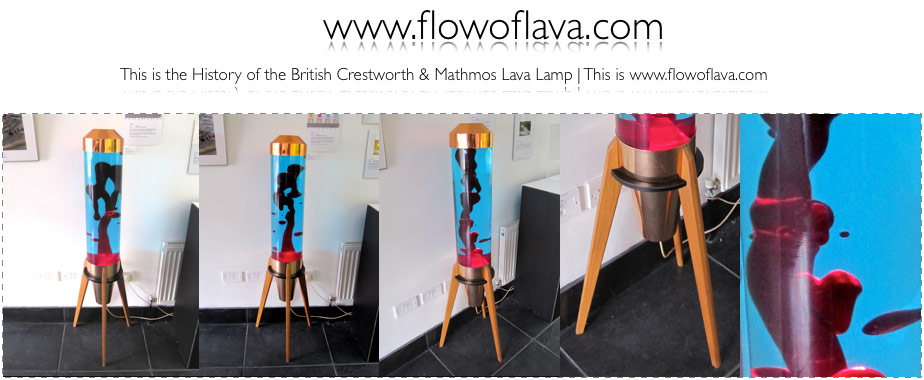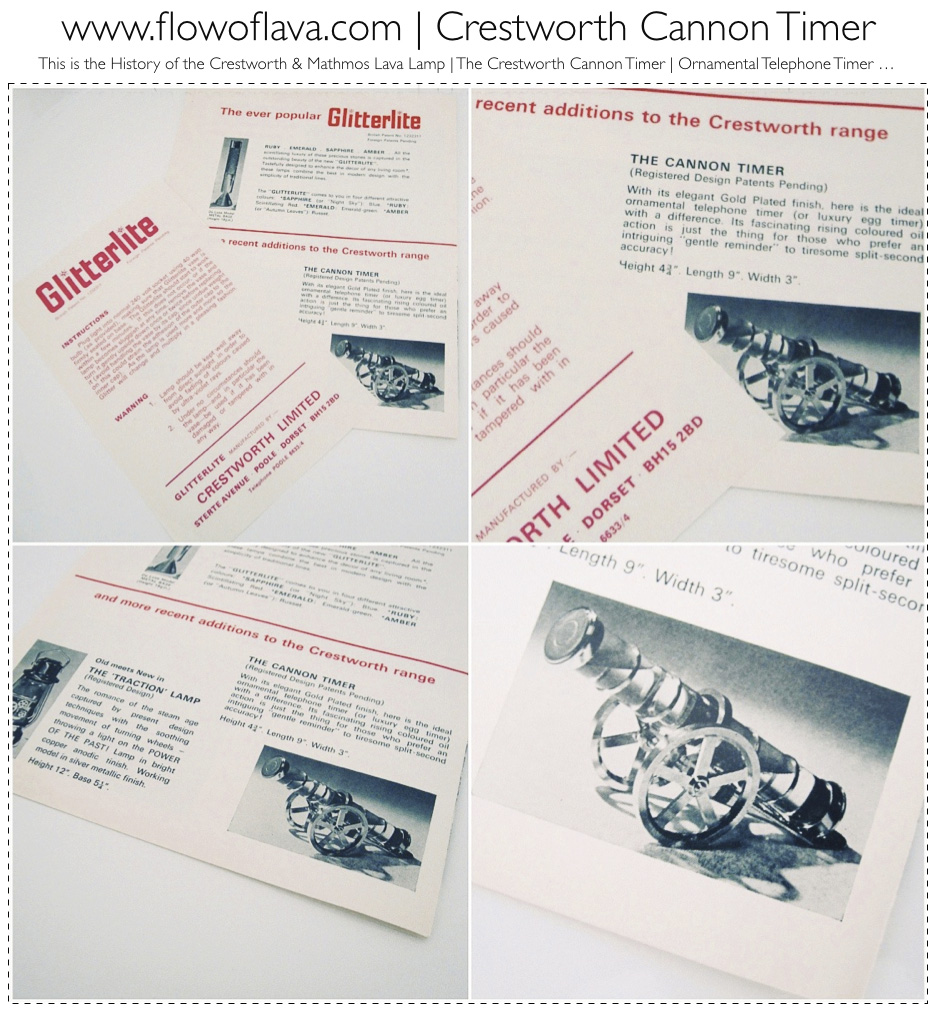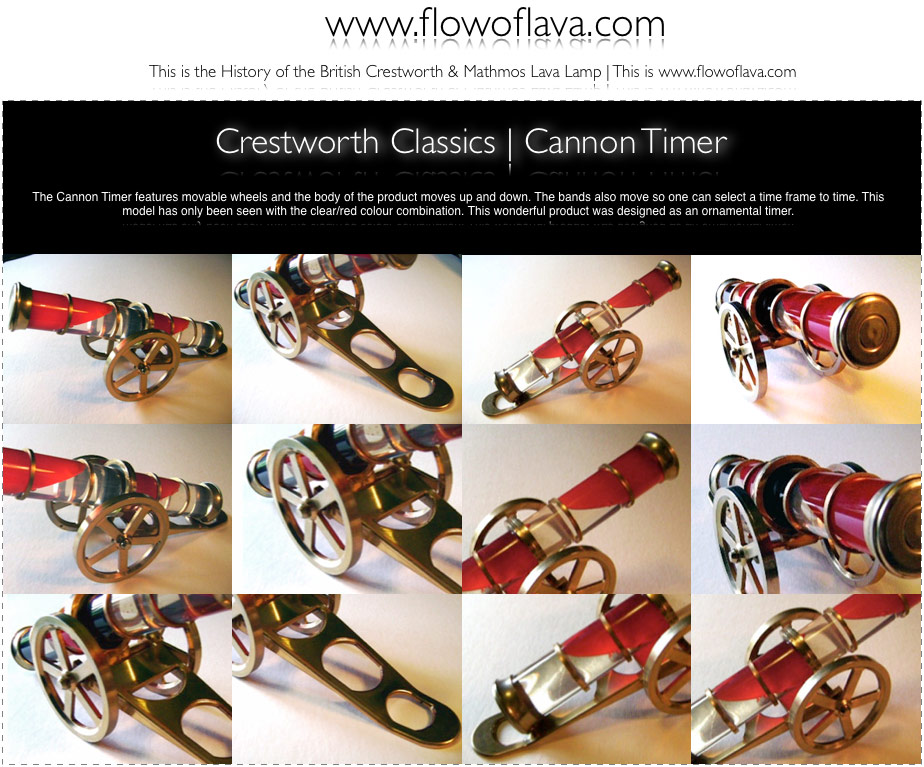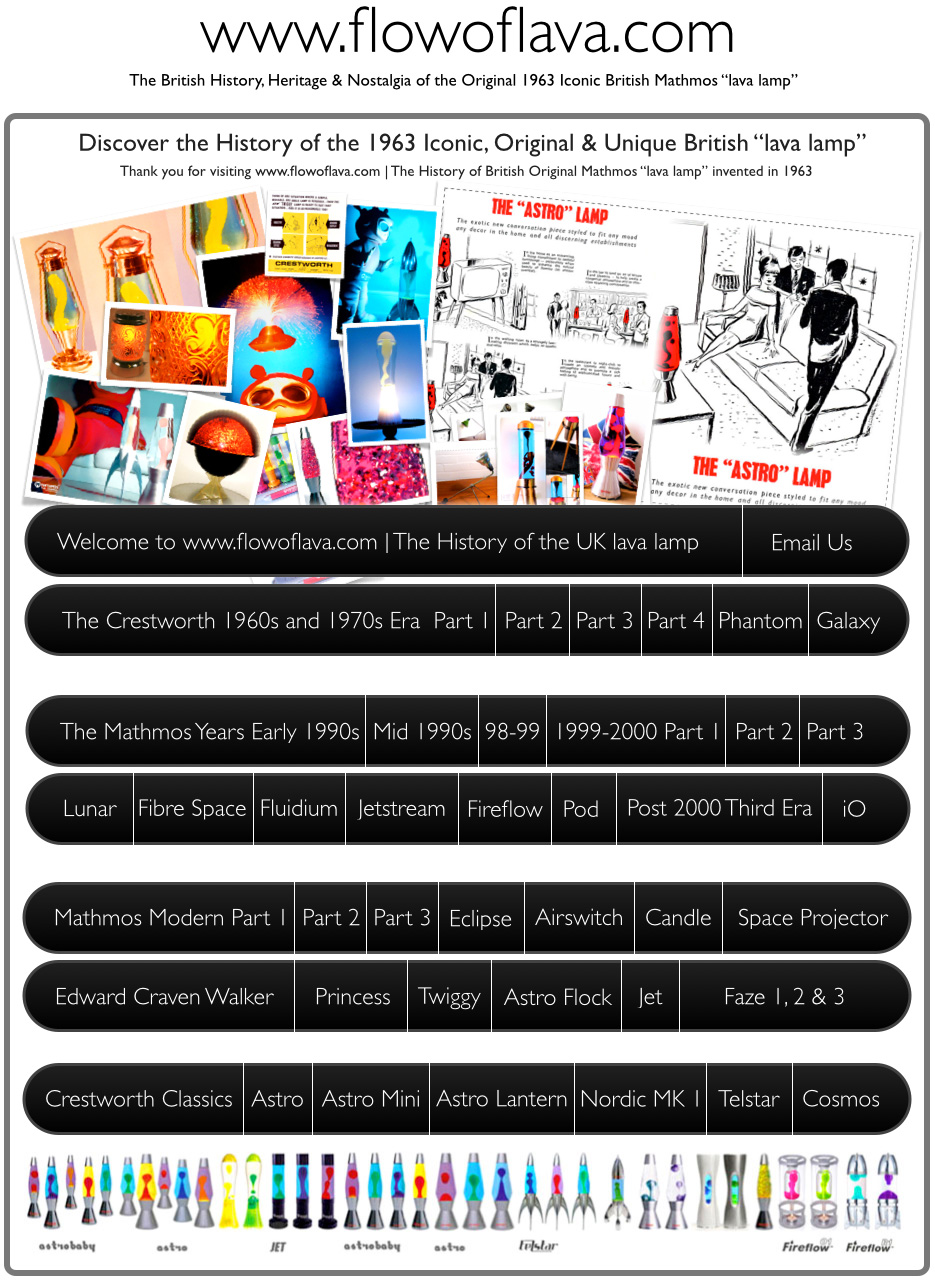
![]()
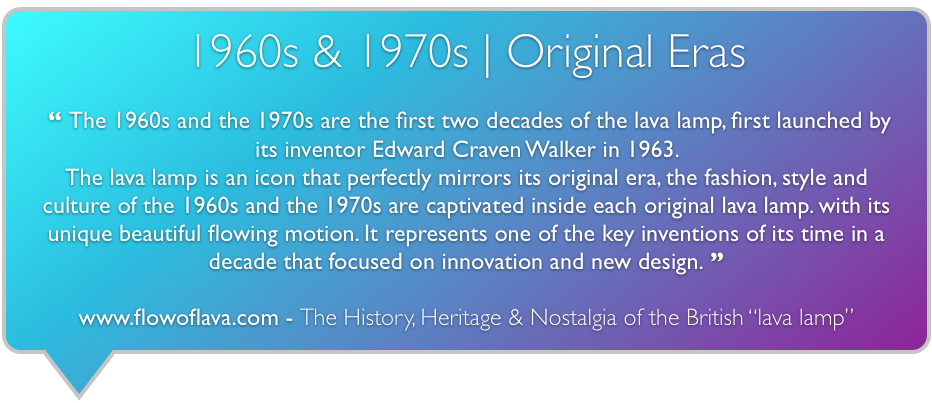
Welcome to www.flowoflava.com | Crestworth Astro & Astro Mini | The Original World's First Designs by Crestworth Ltd. Below one can see an early brochure showing the Astro & Astro Mini, the world's first two lava lamp designs produced by Crestworth Ltd and illustrated by Roy Weston. Crestworth Ltd was formed in September of 1963 and Mr Edward Craven Walker who invented the lava lamp first launched the first design known as Astro, manufactured on West Quay Road in Poole. Over the years Mr Walker started releasing more derivatives of the Astro in beautiful designs. Edward Craven Walker founded Crestworth Ltd with offices in London and in Poole. This first page of the website is designed to look at the early Crestworth range, the world's first lava lamps. Following the iconic Astro lamp, Mr Walker's second design Astro Mini offered a more sleeker alternative. This is the history of the lava lamp. Enjoy the images below ... |
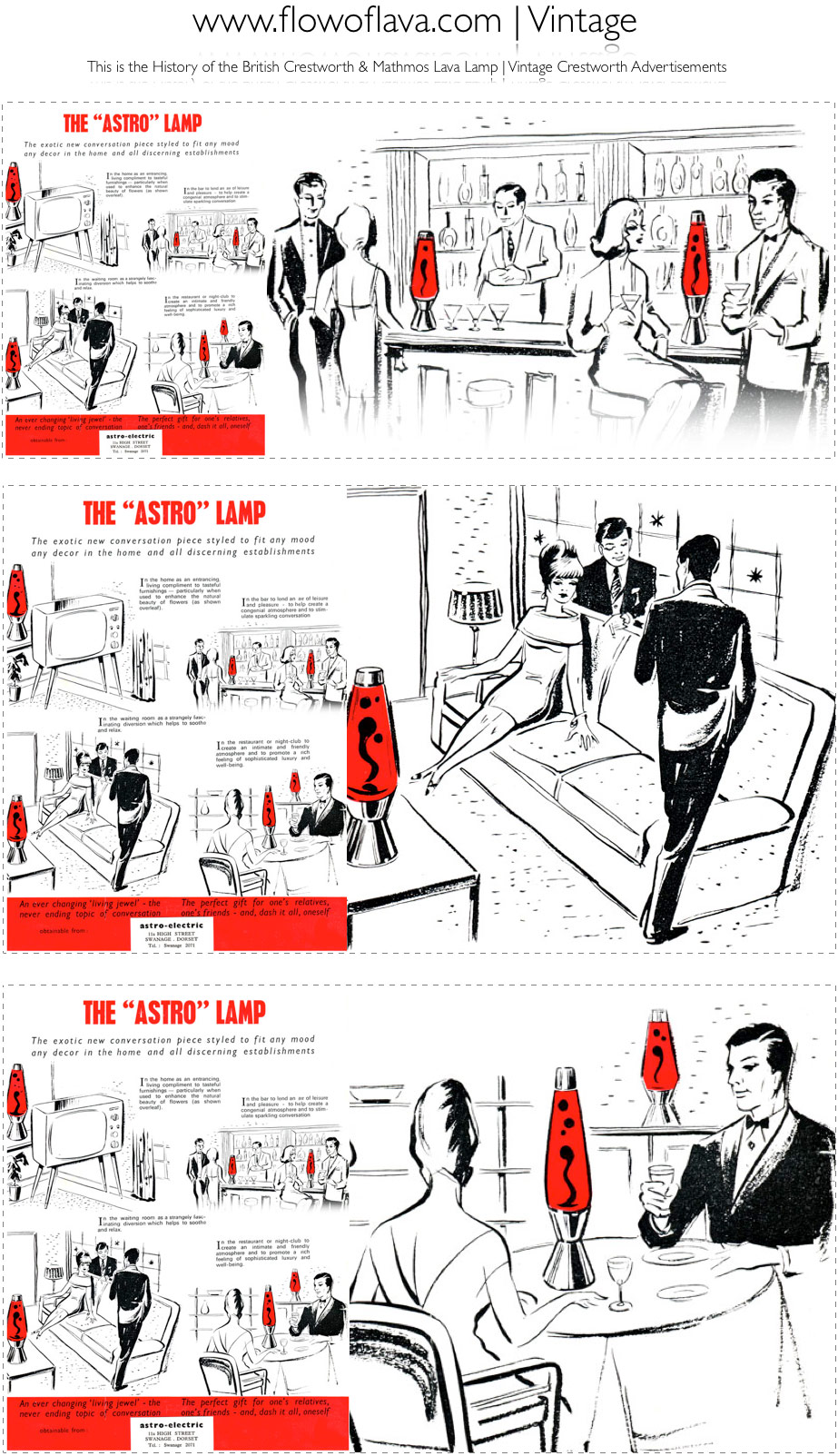
![]()


www.flowoflava.com presents The Crestworth Astro | MK0 Origin Design ... www.flowoflava.com is proud to feature a very early Crestworth Astro MK0 Lamp, which was beautifully restored by Eliot Lees, who has restored this classic piece of lighting history, giving it a new home and lease of life. MK0 Astros are some of the very first Crestworth Astro lava lamps ever produced, featuring the liquid formulation and an open top container. Learn more about the history of the Astro lamp below ... |

The Crestworth Astro Lamp | The Evolution of the Astro Lamp over the vintage years ... The Astro, evolved through the 60s and the 70s, this history has been sequenced. Below are some details on the various designs of the Crestworth Astro. After numberous prototypes and patents the Astro was released in September 1963. The early Astro had a liquid base as apposed to solid wax and came in a copper anodised finish. Early designs of the Astro can be seen in the Cult TV Series: The Prisoner. The Astro progressed from using a liquid based formula to a solid based formula, which proved to have several advantages and was resistant to the shipping requirements. Astro was a model but also became a term to refer to the other pieces in the collection. Below is a list to assist you identifying your Astro lamp ... MK0 Origin Design: The Beginning... We have created a special reference code: MK0 to differentiate and identify the very first early Astro lamps. The very first early Astro lamps feature a hand-blown crystal glass container, which is actually not a bottle but features novel methods of creating a water tight enclosure. One such method which was used was a glass disc placed inside the lamp's copper cap and angled slots ground into the bottle's crystal glass. This allows the two dimples in the cap to align and grip the bottle and this is then glued in place. Another idea seen in these early Astro lamps is a very clever two part metal locking system and o-ring seal as seen in a patent referencing inventor David George Smith on behalf of Crestworth. MK0 Astro lamps feature the classic early two part base but with the inner sections of the base coated in white. Also the MK0's bottle cap is extremely thin. Origin Astros feature near instant start up time due to their all liquid formulation that remains liquid when the lamp is switched off. MK0 were transported by Crestworth's vans and also by 'Smokey'(Colin & Jean). MK0 Astros were produced between September 1963 to Summer/ September 1965 when the solid lamp was perfected by Crestworth. Please note that Origin Astros may also be seen with solid wax, as they could have been sent back to Crestworth for refilling at a later date. Their defining feature is the open top container. MK1 First Design. Early First Generation Astros have a two part design, which features two cones that slip into one another, the power cable runs between them. They also feature an exposed green earth wire. Early Astros used wide-neck bottles and very thin caps. Thus they showed the level of the fluid when the lamp is switched off and the air gap at the top. People often think they are missing fluid but this is not the case. Unlike Origin Astros these feature sealed bottles instead of an open top container ... MK2 Second Design. Second generation Astros also feature wide-neck bottles with a flatter style top which shows the level of the fluid. Also the second generation Astros feature a metal plate on the base which prevents you from touching the interior. The earth cable and power cable go through this earth plate via a hole in the center of the plate. MK3 Third Design. Third generation Astros have the same wideneck bottles. The base is a two part construction. The base features two lines/ bands on the upper part of the base. The base is felted and often has four bubble feet. MK4 Fourth Design. The fourth generation Astro, brought a slimmer style bottle. The base is nearly identical to the 3rd generation Astros and features the same 2 indentations/ lines/ bands on the top part of the base. Where this design differs to the 3rd, is that this design has 5 bubble feet which gives the base added stability. This base was also green felted on the underside. MK4.5 Fourth Hybrid Design. There is also a variation of the fourth generation Astro lamp, known as the fourth Hybrid design (aka: Mk4.1 or Mk4.5) which features the slimmer bottle, a one part metal base construction to facilitate the bakelite black base plate which is commonly seen on the fifth generation Astro lamp. However the base is slightly taller and features the two bands, as seen on the fourth Design. MK5 Fifth design. The Fifth generation of the Astro, is the most commonly seen 1970s model, and uses standard Astro bottles. It features the base metal work spun in one part that surrounds the bakelite base plate. The lamp has no earth and it was more inexpensive to produce. Having said this, it is still a beautiful piece. The immediate sign of the 5th Generation Astro is the bakelite black base plate on the base, which features the Crestworth details on the underside. |
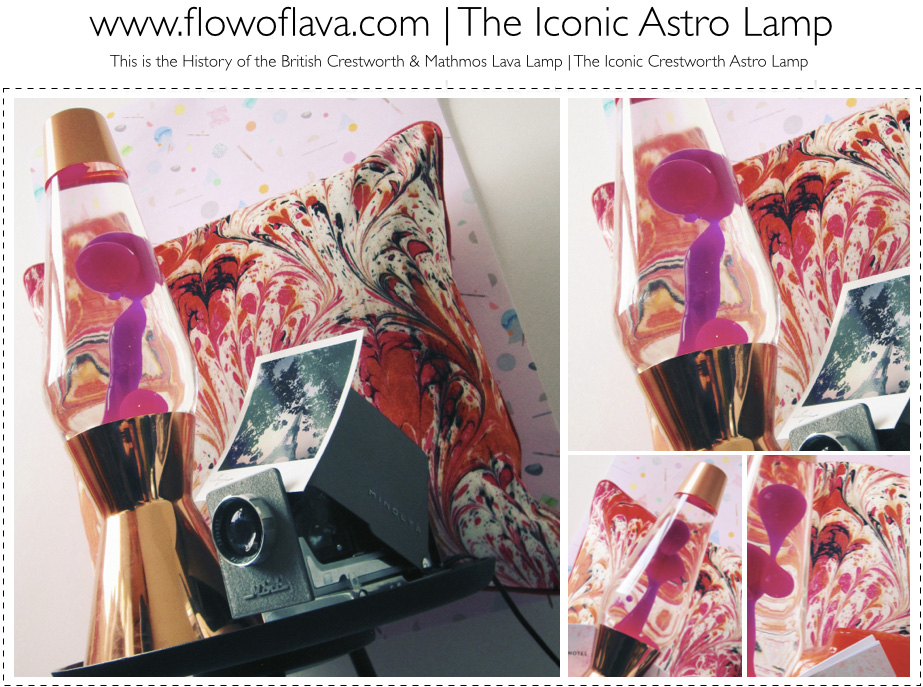
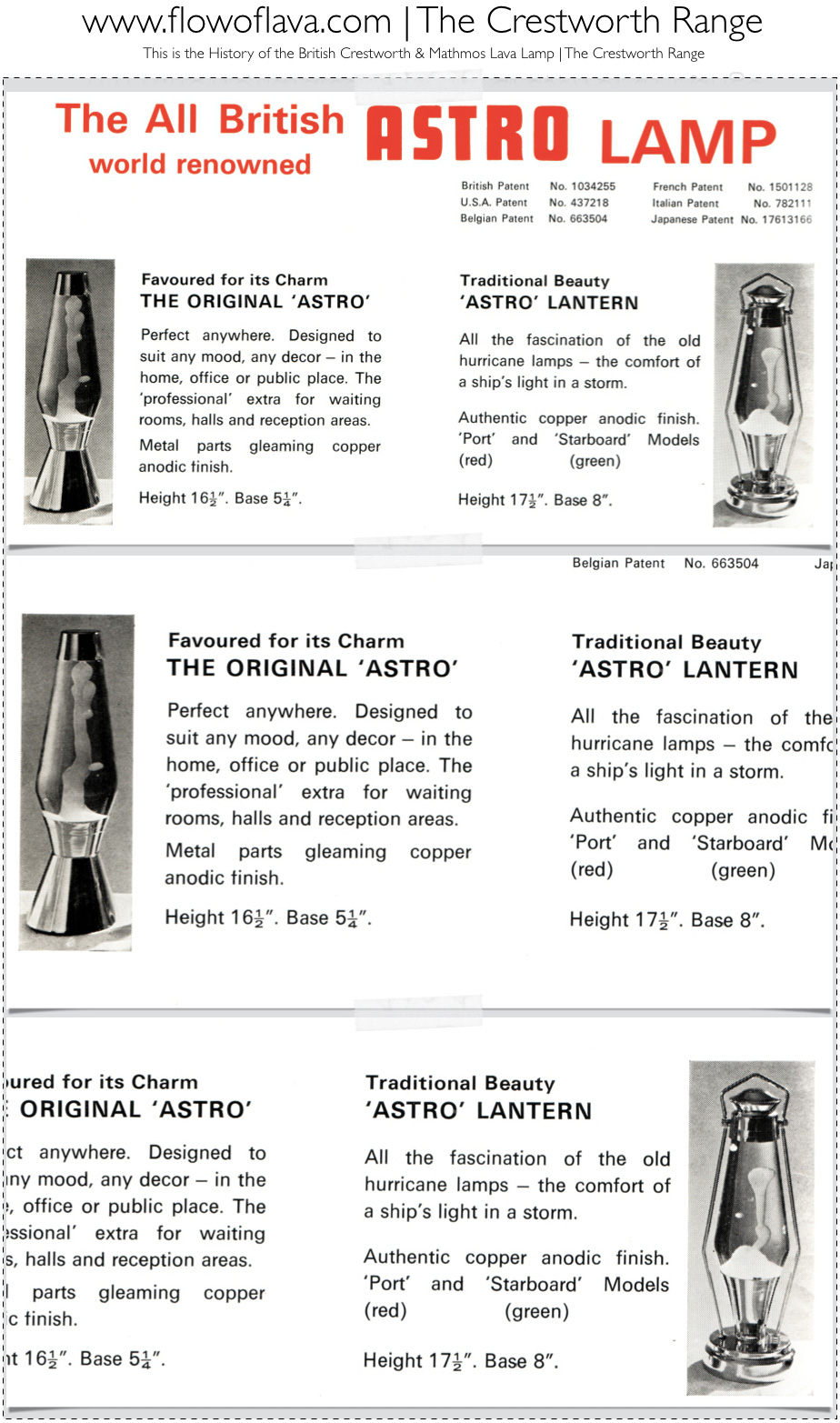
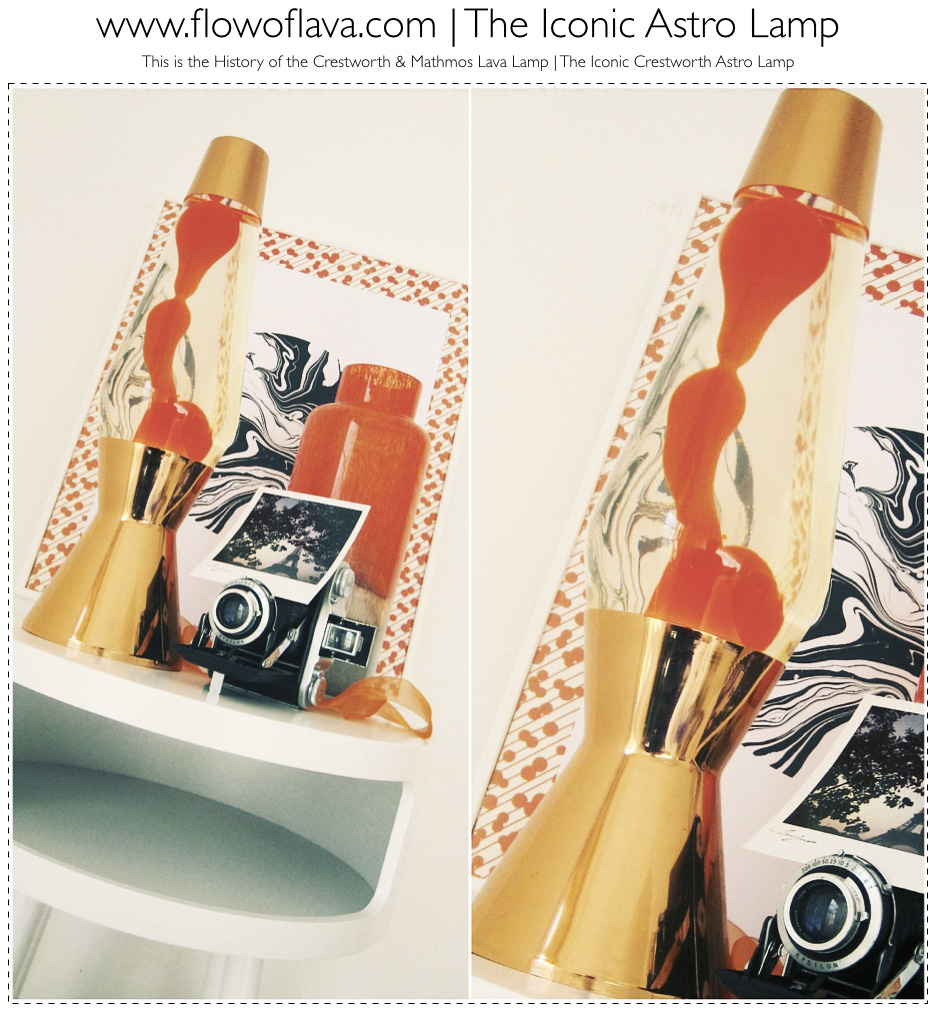
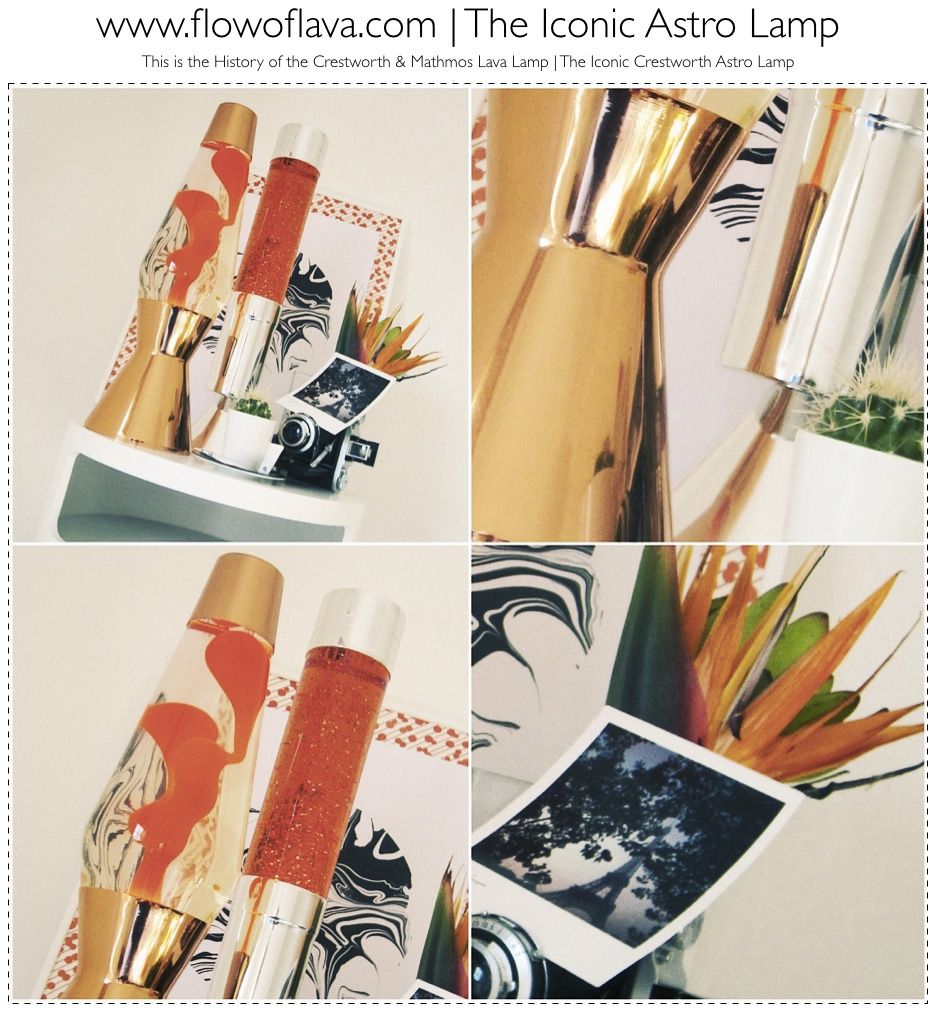
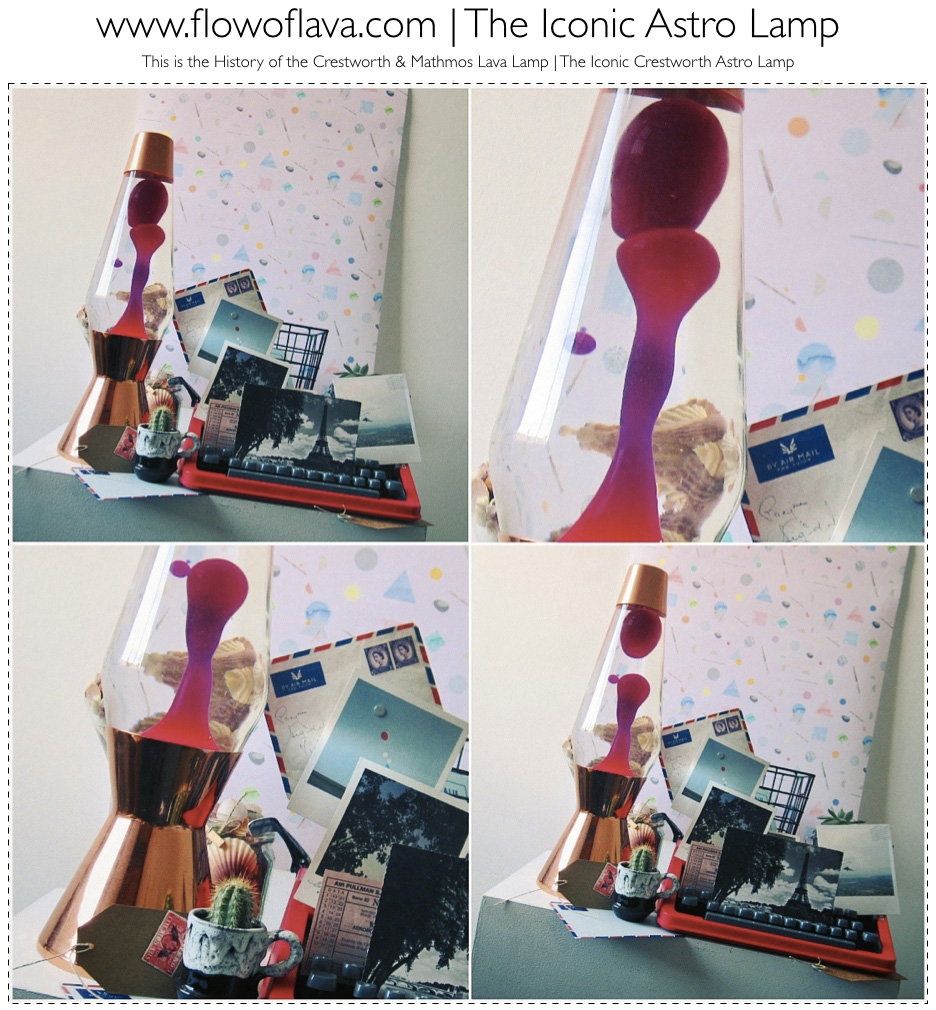
![]()
Crestworth Astro & Astro Mini | The Early Colour Combinations ... The images below show a rare scan from a vintage Crestworth advert. Describing the lamps as: Rising, Dancing, Twisting, Fascinating Fluidity, they offer a selection of wonderful jewel motion colours for everyone. A lava lamp is comprised of the lava liquids featuring masterfluid and a sold moving base (wax). In this rare brochure the colours stated are: Masterfluid: Rose, Primrose, Clear, Yellow-Green and Blue-Green Wax: Ruby, Topaz, Amber & Emerald |
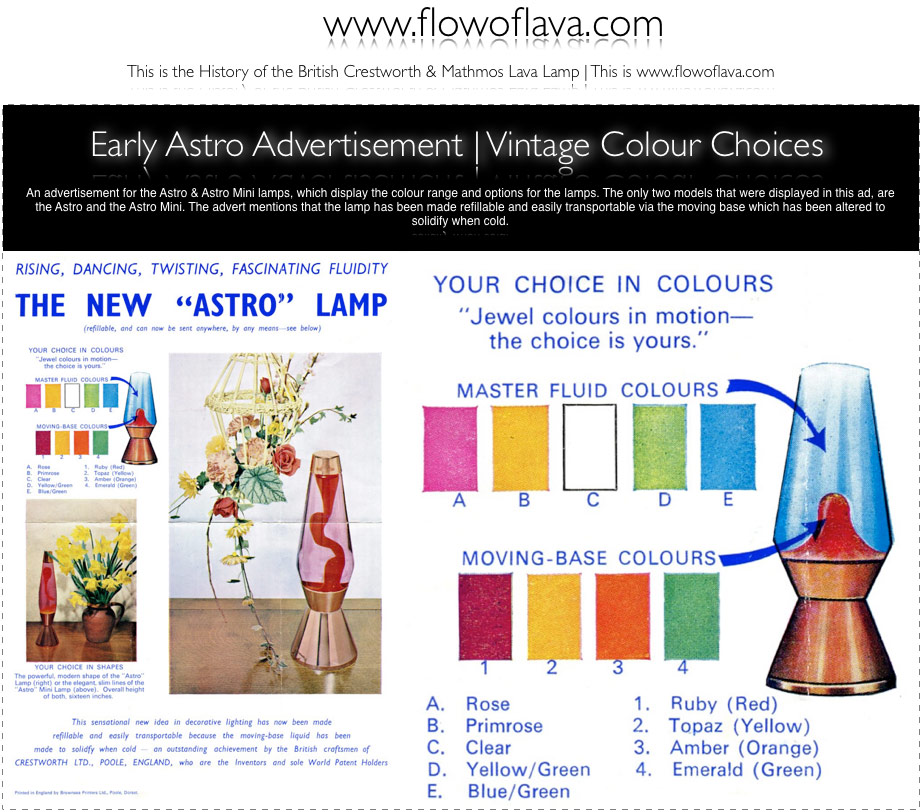
![]()
The Early Astro Mini | Boxed and Mint seen below | Open Base Mini Design | Astro Mini Types ... The Early 1960s Astro Mini had an open base design and featured shorter bases than the 1970's Crestworth Astro Mini. The early editions of the Astro Mini were open at the base and later editions featured a Crestworth Bakelite black base. The images below show an early Astro Mini. There are several ways one can recognise an Early Astro Mini. If you turn the lamp base upside down. Never turn the lamp bottle upside down! You will see an open base which shows clearly the wiring of the lamp. The green cable is the earth cable that is attached to the screw. Also please note the Arco electric bubble style switch. The Astro Mini design is slightly shorter than the later Astro Minis making the lamp look a lot more stubby. No MK0 edition exists as no open top container was used in this design, unlike the Astro lamp. All designs use a 40w SBC bulb. MK1... Open Base. Two Part Base Construction. TreeTop bottle. MK2... Open Base. Single Part Base Construction. TreeTop bottle. MK3... Designed for speed of manufacture to accomodate the black Crestworth bakelite base plate. Single Part Construction. TreeTop bottle. |
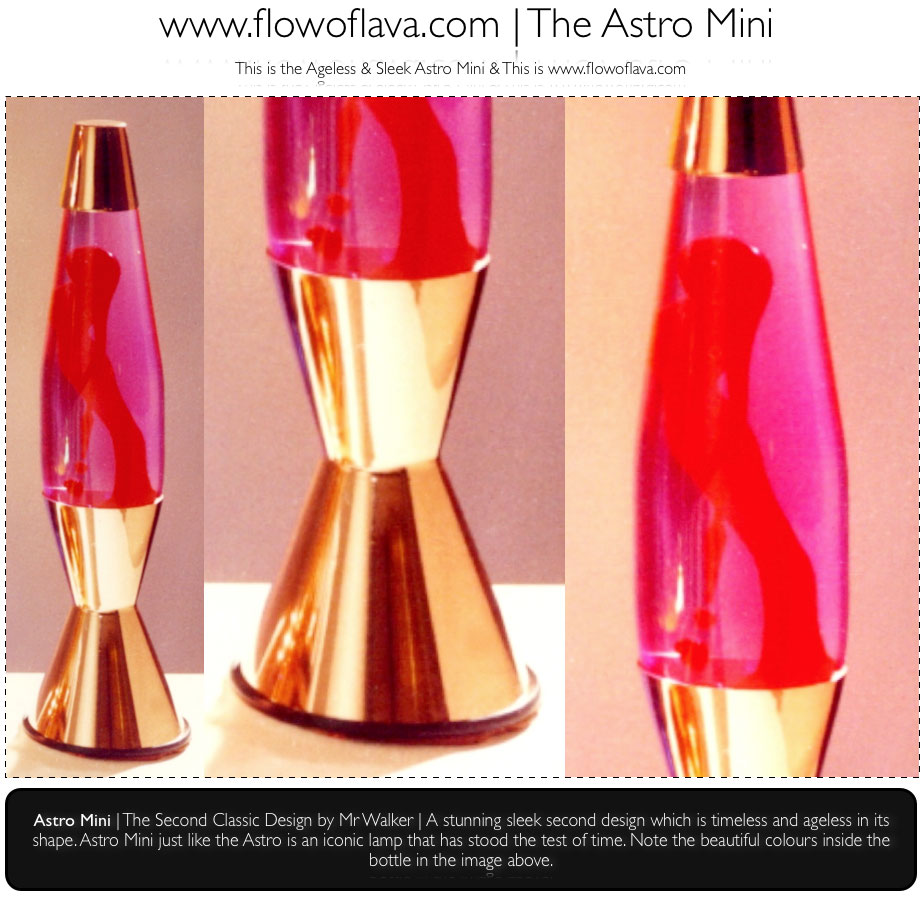
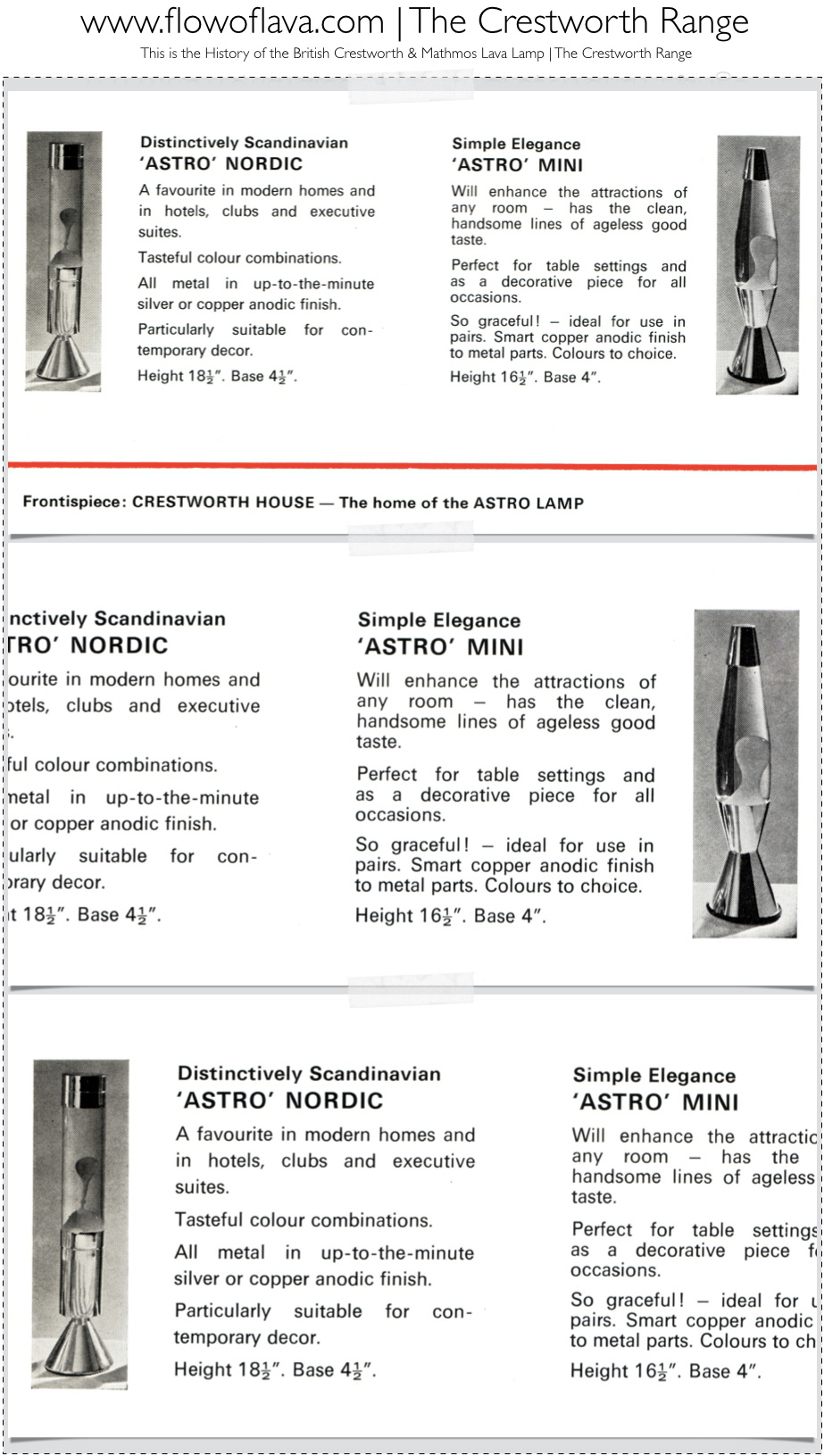
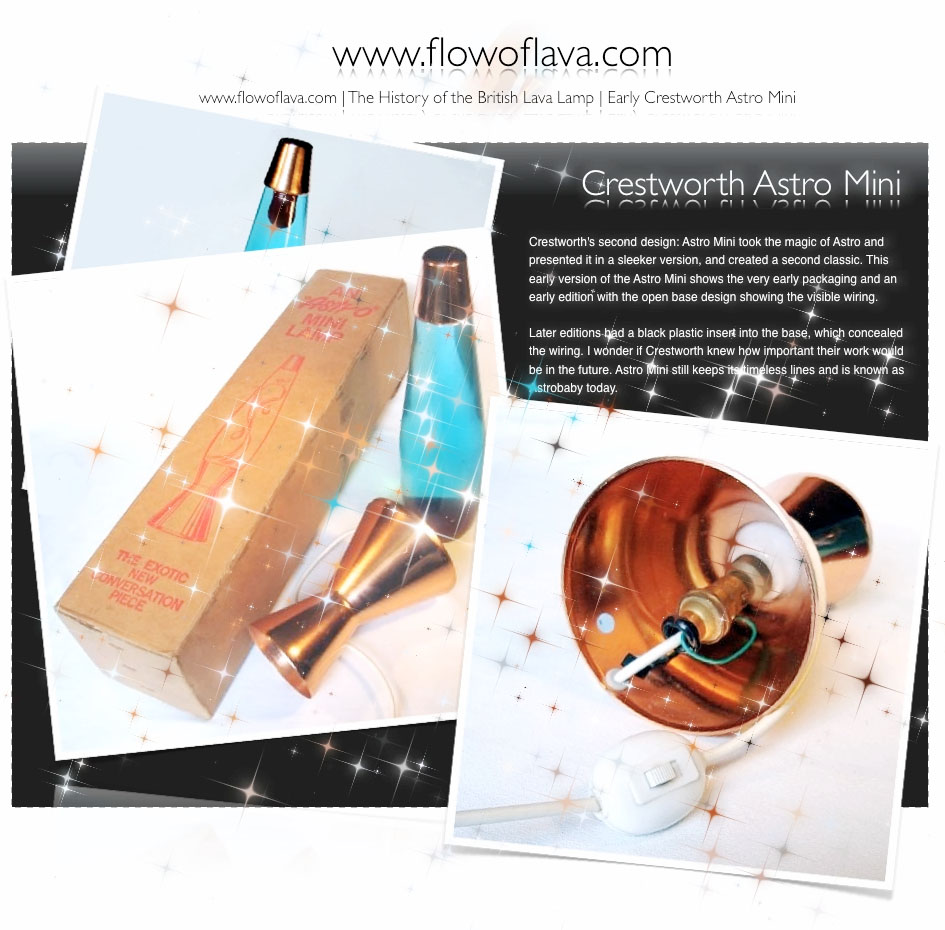
![]()

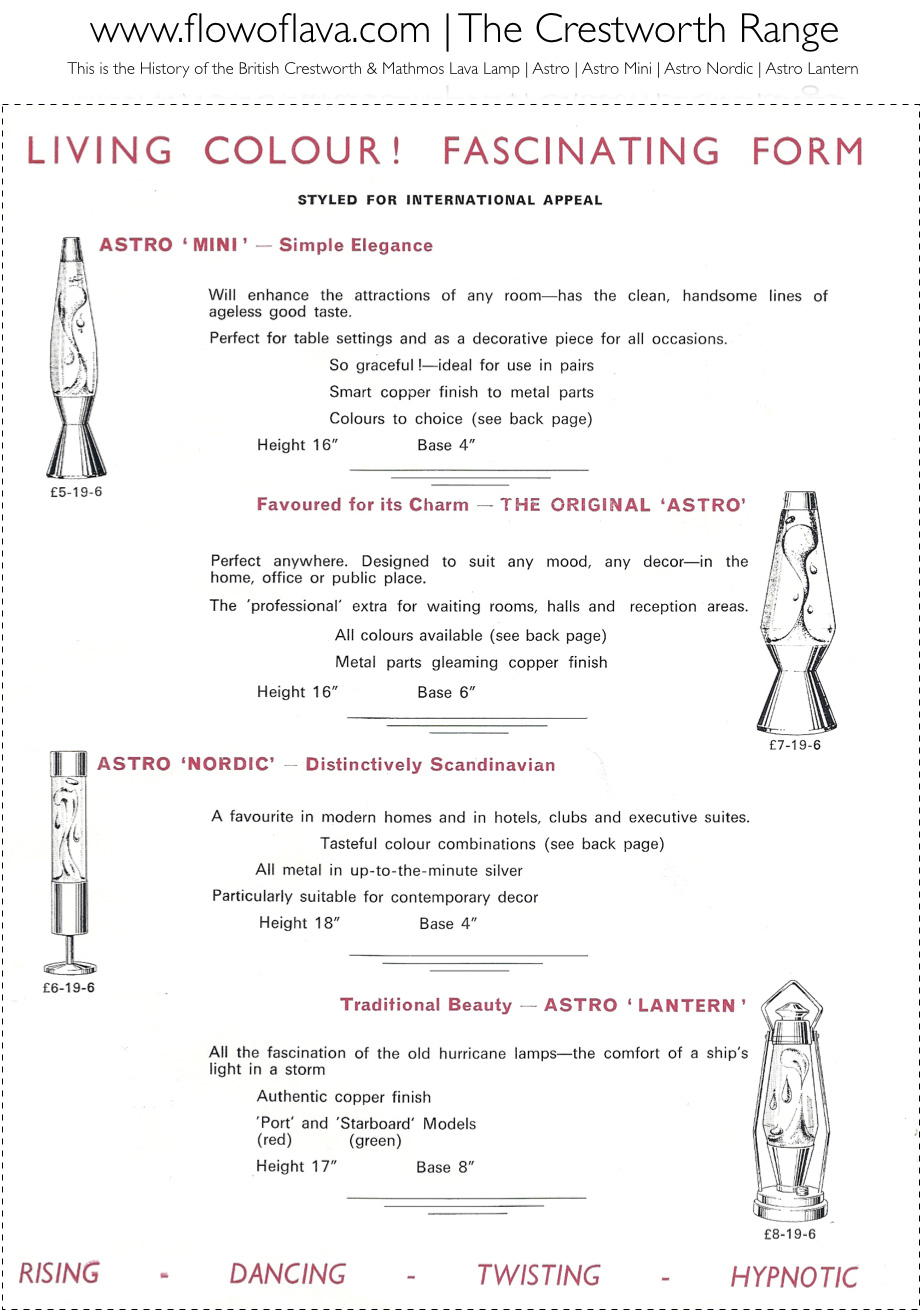
The Crestworth Icons | These are Originals | These are the icons | These lamps started the lava lamp range. Over the years Crestworth created a range of stunning designs. From the Astro to the Astro Nordic to the Astro Lantern to the Astro Mini, there are designs for different people and different tastes. Crestworth also later launched other designs such as the Living Jewel featuring the Astro Nordic de luxe base and cap configuration and the Telstar range. One can also see the Crestworth Astro Lantern. Astro Lantern products are extremely beautiful, rarely found with the original bottle they do look great with just about any kind of coloured bottle, but the Lantern seems to go great with all kinds of colours, below you can see one restored with a Blue/Blue bottle. Product lineup: Favoured for its Charm THE ORIGINAL "ASTRO": Perfect anywhere. Designed to suit any mood, any decor - in the home, office or public place. The "professional" extra for waiting rooms, halls and reception areas. Metal parts gleaming copper anodic finish. Please see below for the packaging. The box reads: The exotic conversation piece AN "ASTRO" LAMP by Crestworth Ltd. TRADITIONAL BEAUTY "ASTRO LANTERN" - All the fascination of the old hurricane lamps - the comfort of a ships light in a storm. Authentic copper anodic finish. Two models were produced "Port" - Red and "Starboard" - Green Models. |
![]()
![]()
![]()
![]()
![]()
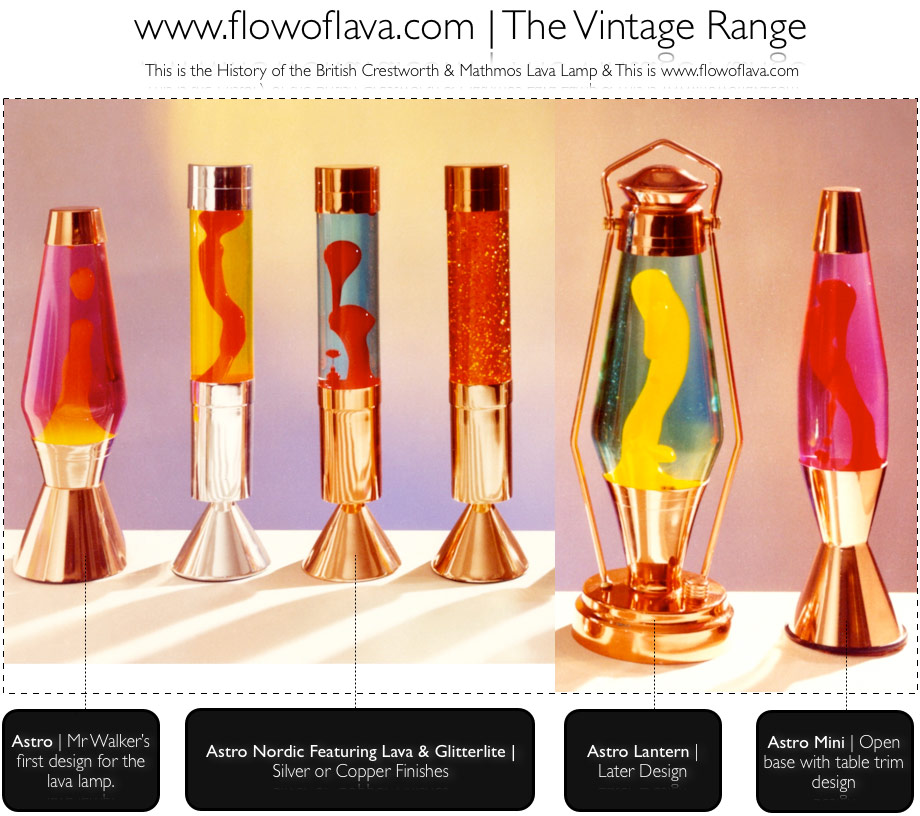
![]()
The Crestworth Icons | These are the Originals | The Crestworth Astro Lantern TRADITIONAL BEAUTY "ASTRO LANTERN" - All the fascination of the old hurricane lamps - the comfort of a ships light in a storm. Authentic copper anodic finish. Two models were produced "Port" - Red and "Starboard" - Green. Port consisted of Rose masterfluid and Ruby wax. Starboard consisted of Blue masterfluid and Topaz wax. |

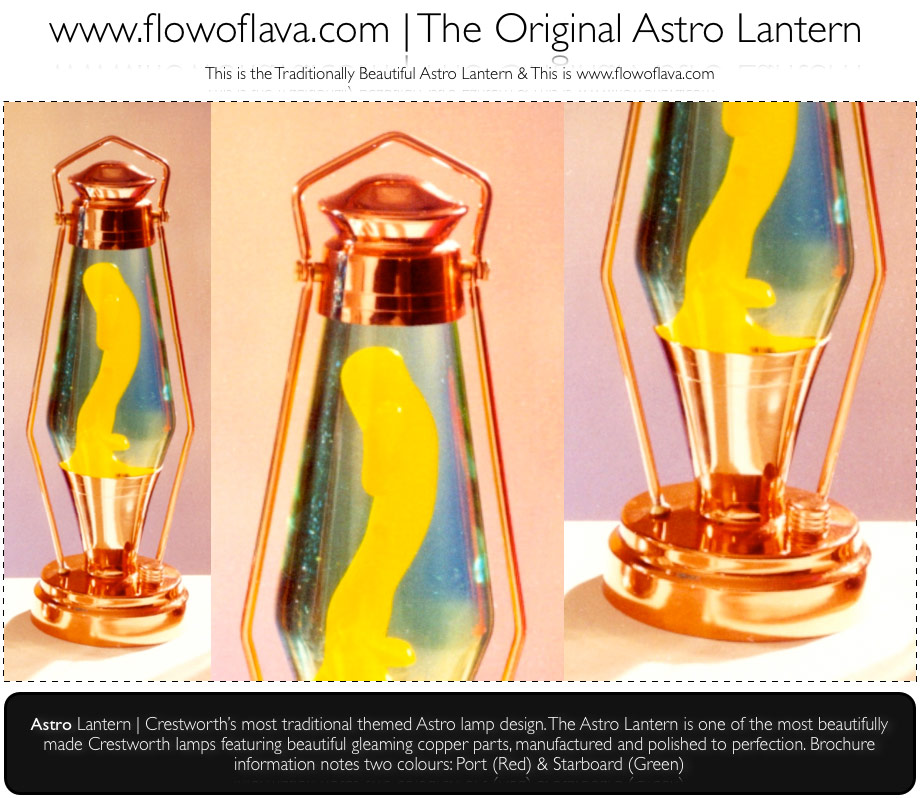
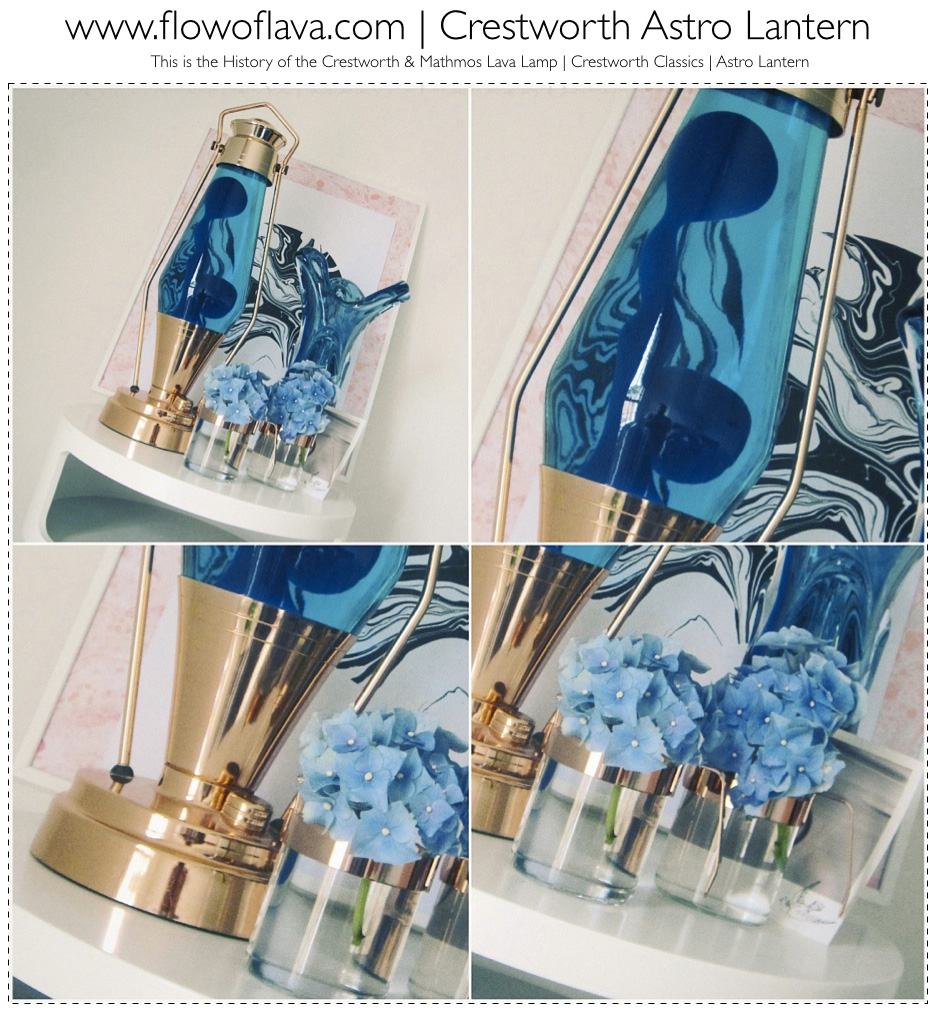
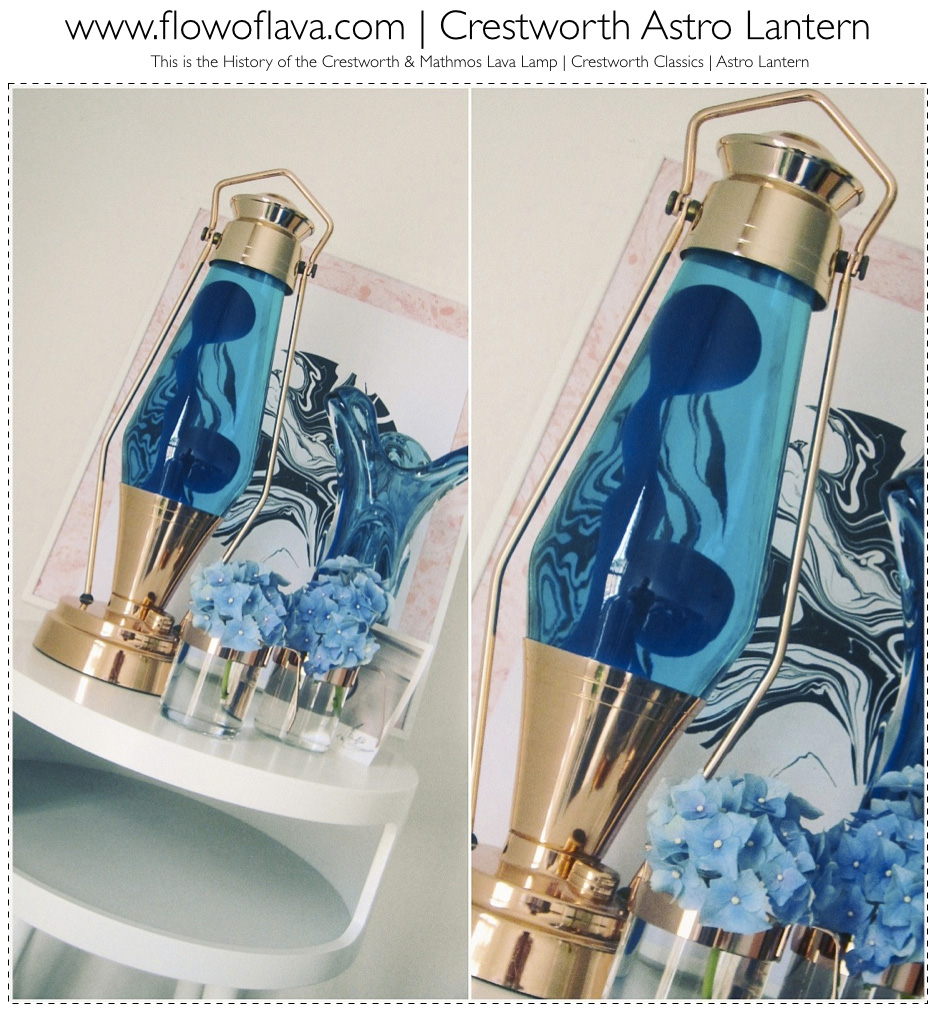
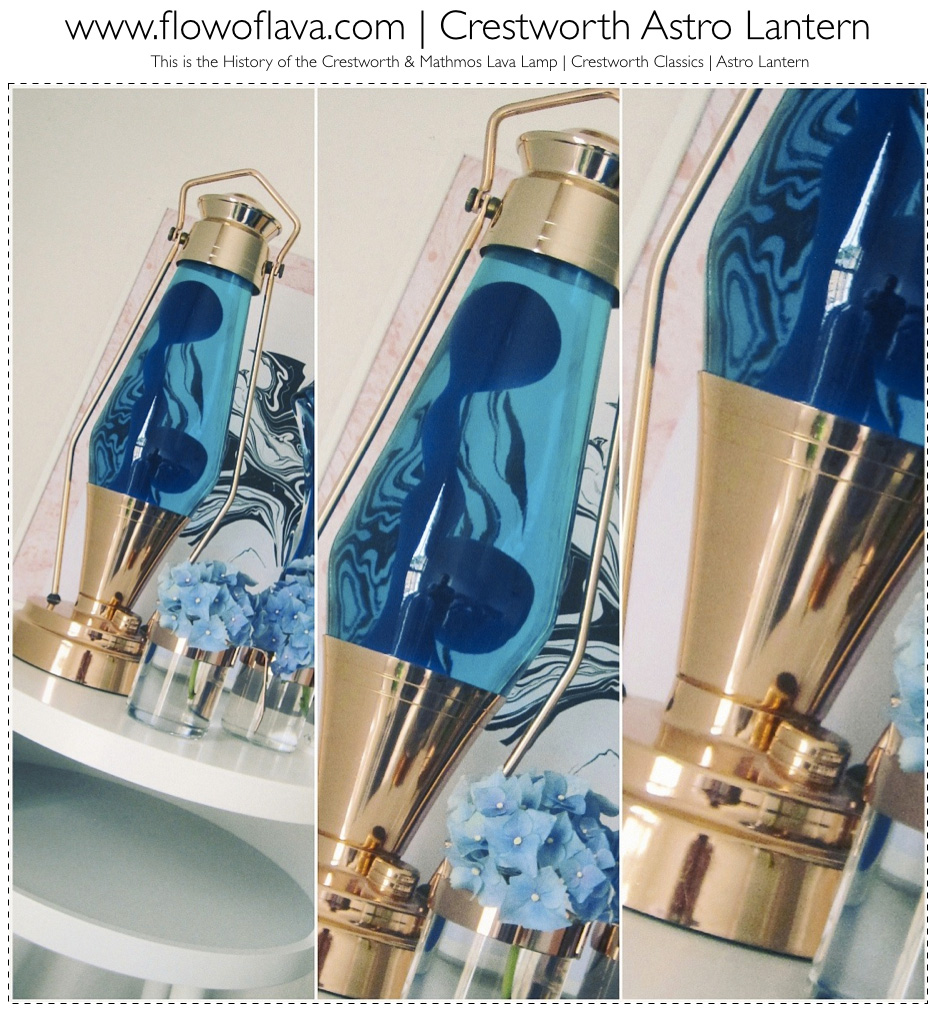
![]()
The Crestworth Icons | The Export Model | Cosmos Cosmos Design - A rare lamp design which was the first Crestworth lamp which used the "jet" type bottle and pre-dates the Astro Nordic design. It features a cyclindrical metal shape that houses a "jet" style bottle, the base design then forms a thin metal rod and wider base. The flex on this is the red/black and green colour code earth wire attached to the base via a screw. The design was also made in copper but it is very rarely seen. These lamps are very elegant however they were designed for export markets. They are often seen in France, and also seen documented in a French Crestworth Brochure. Here are the colour combinations for the Cosmos, from an Early Crestworth French Brochure. They were featured in both slow moving Glitterlite and with lava. Glitter Colours: Pink (Rose), Amber (Ambre), Blue (Bleu), Green (Vert). Original French Export Lava Colours written in French: jaune-bleu, rouge-bleu, rouge-rose, rouge-jaune. Please note that the wax colour is listed first, then the liquid masterfluid follows. Original Lava Colours translated in English: yellow-blue, red-blue, red-pink, red-yellow. Please note that the wax colour is listed first, then the liquid masterfluid follows. This is how the list is displayed in the brochure. |
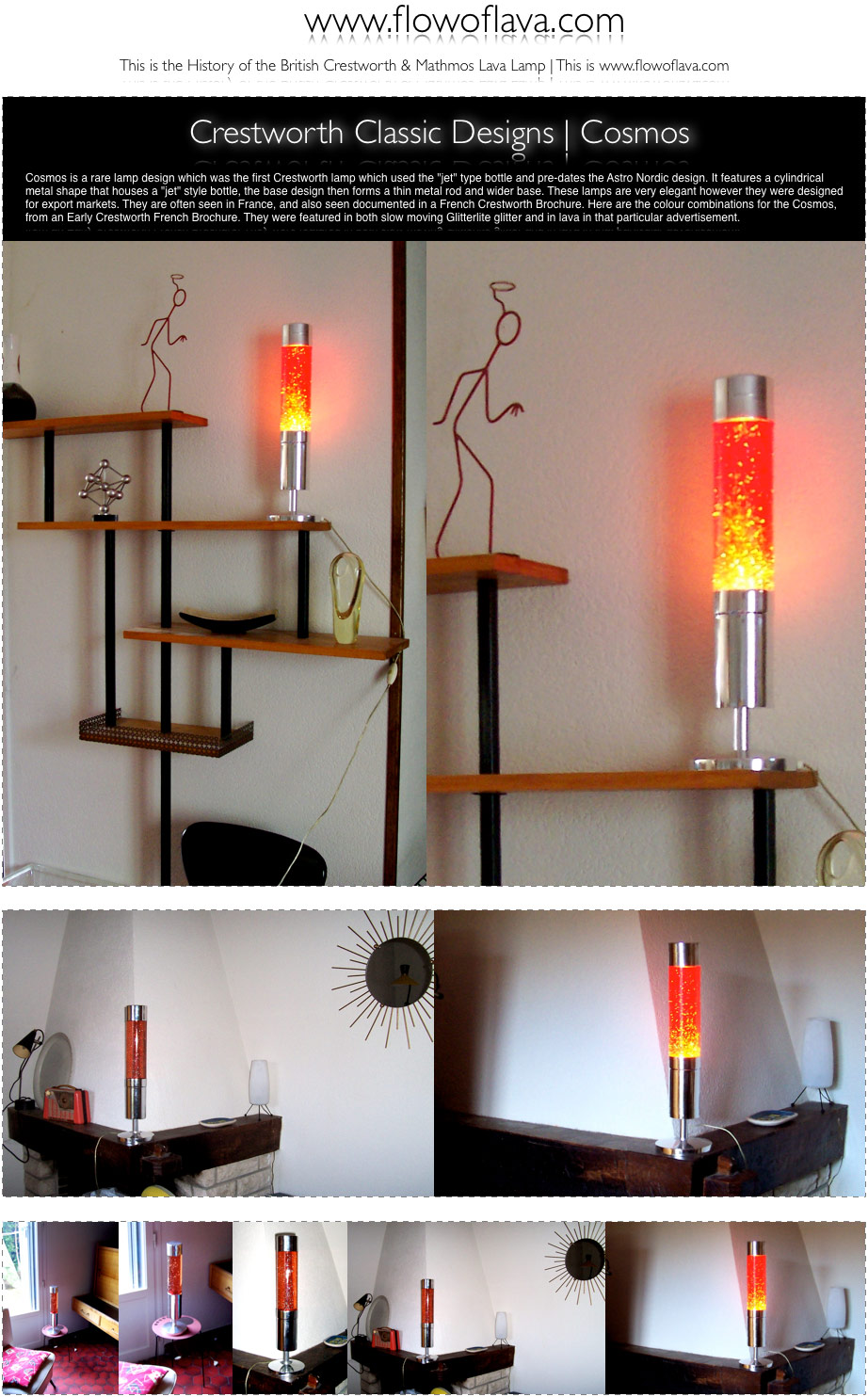
![]()
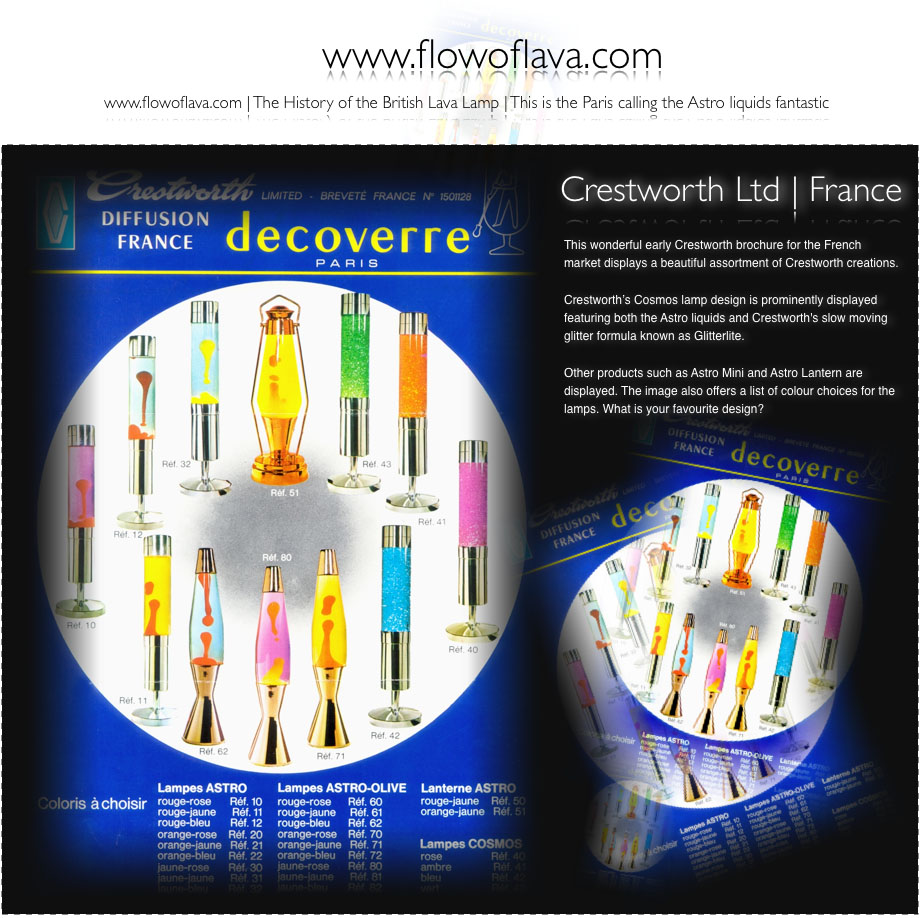

![]()
The Crestworth Icons | Astro Nordic & Glitterlite An example of a Crestworth Nordic featuring the Glitterlite bottle. The Nordic is a stunning design with a beautiful base that looks great everywhere. It is absolutely stunning. The Ever Popular Glitterlite: -Safe Small glitter floating slowing in coloured fluid. Below one can see two examples of the Crestworth Glitterlite. The Glitterlite unlike the Crestworth Living Jewel lamps featured slow moving smaller glitter pieces in an array of beutiful coloured liquid. They are often seen in the Astro Nordic Enclosure, which as a very elegant enclosure. Unlike the living jewels which are fast moving and are solvent based, the Glitterlite is safe and non-solvent based, but features slower moving glitter. Glitterlite bottles are identical to common day Mathmos Jet bottles. They will work in Jet bases and in all cylindrical Crestworth bases such as: the Nordic De-luxe base for example. Distinctively Scandinavian "ASTRO NORDIC" A favourite in modern homes and in hotels clubs and executive suits. Tasteful colour combinations. All metal in up-to-the-minute silver or copper anodic finish. Particularly suitable for contemporary decor. The left image below, shows the lamps assembled. The right image below shows the base which stands on a cone. Max 40w is recommended in the base. Finished with a felted base. Thank you to Orbitz for the wonderful image below of his Crestworth Glitterlite. |

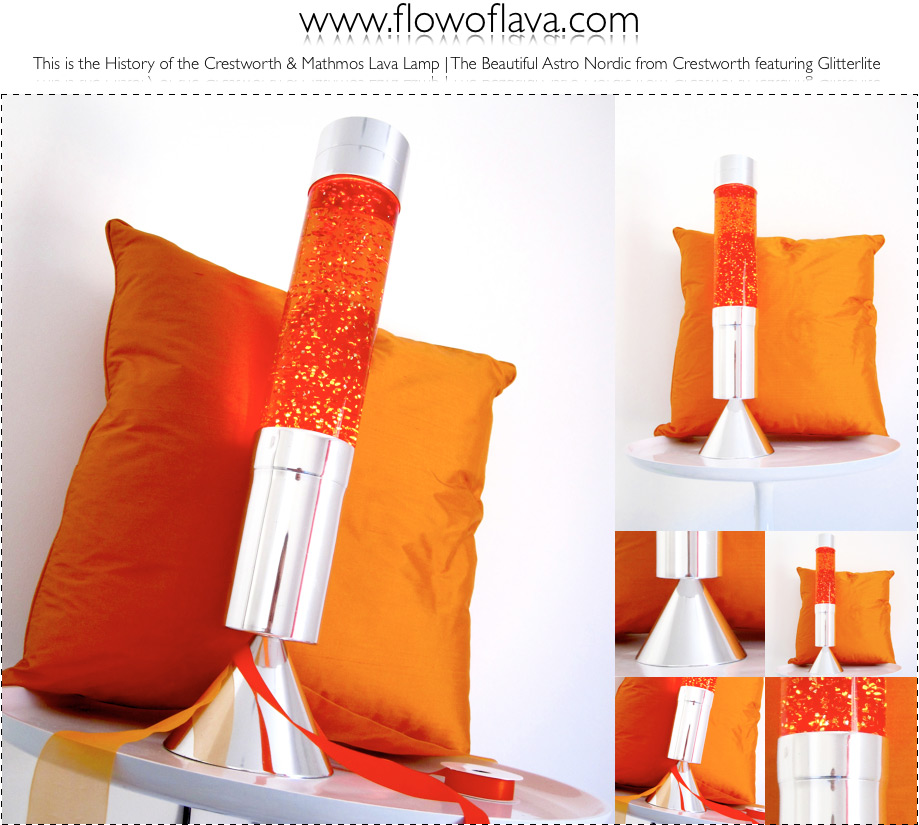
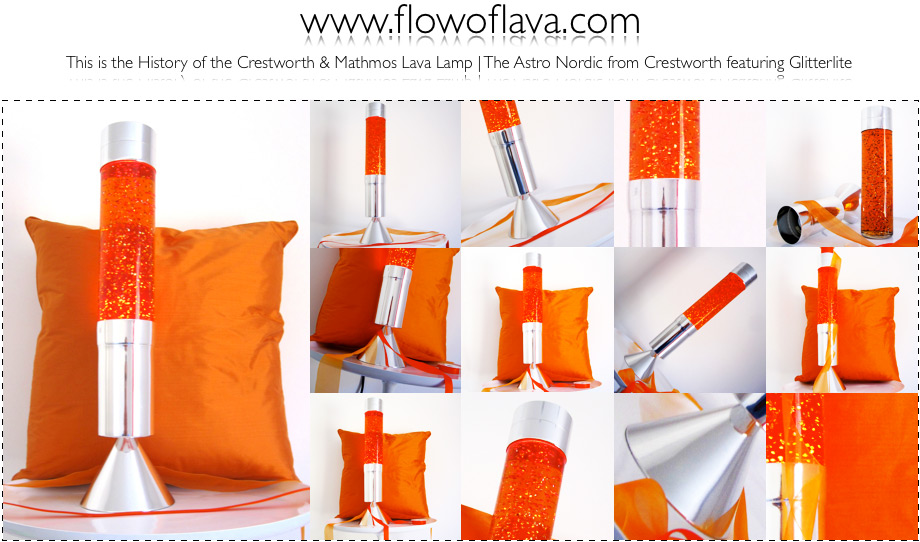
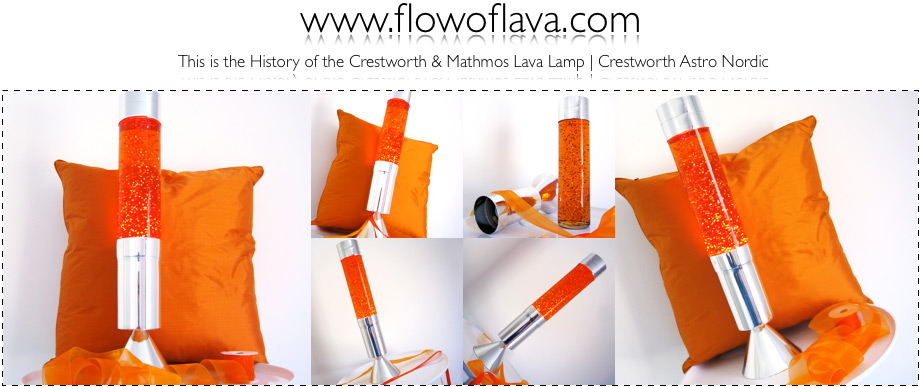
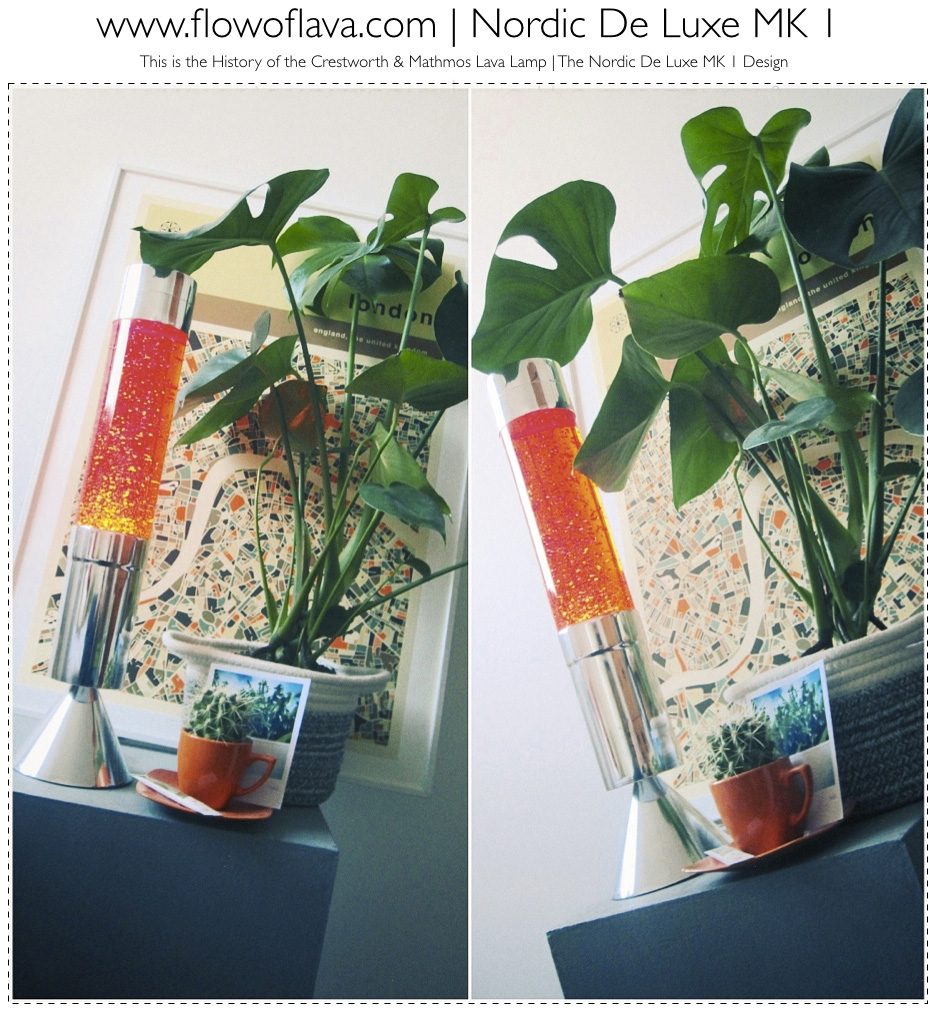
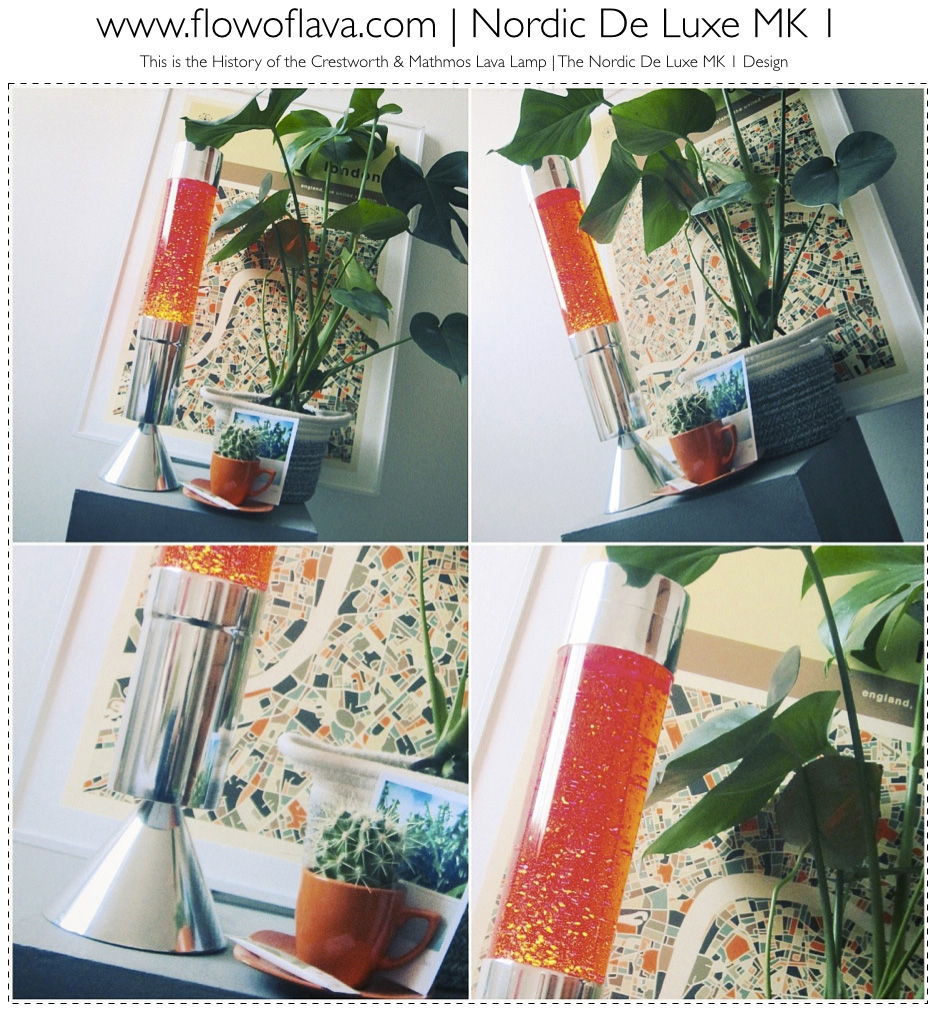
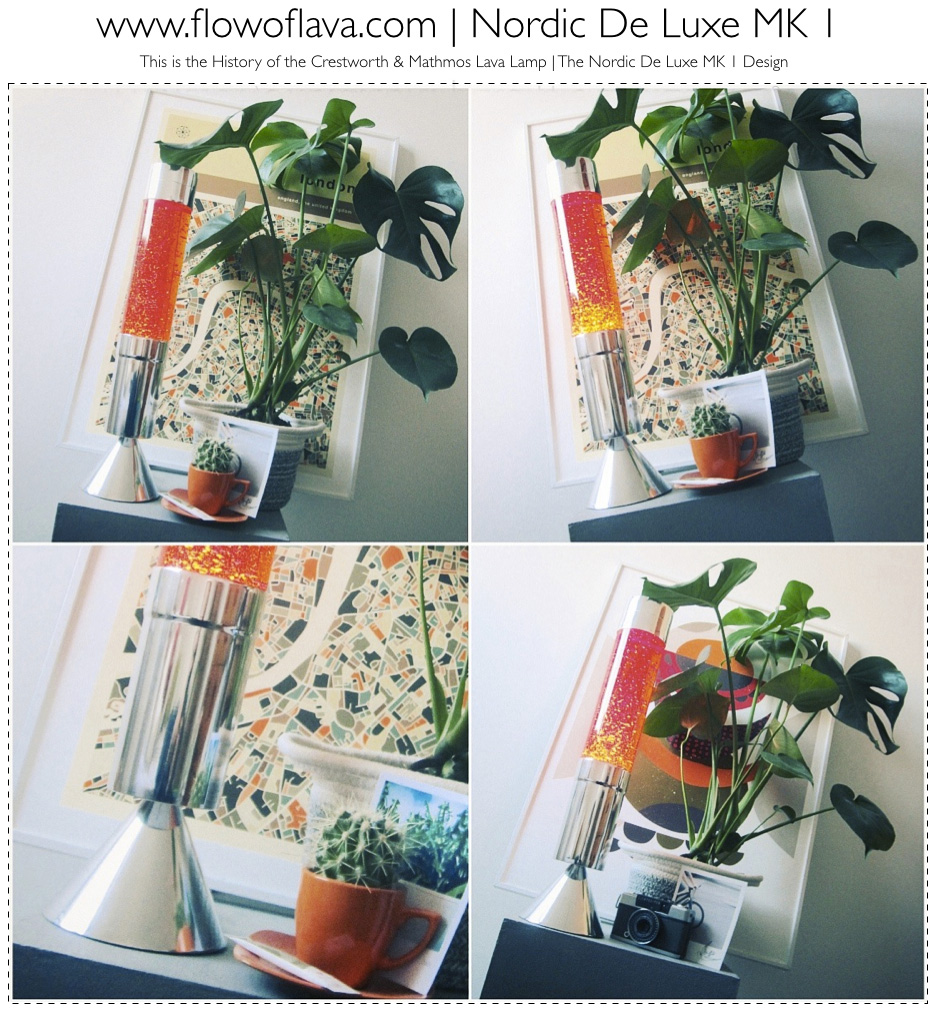
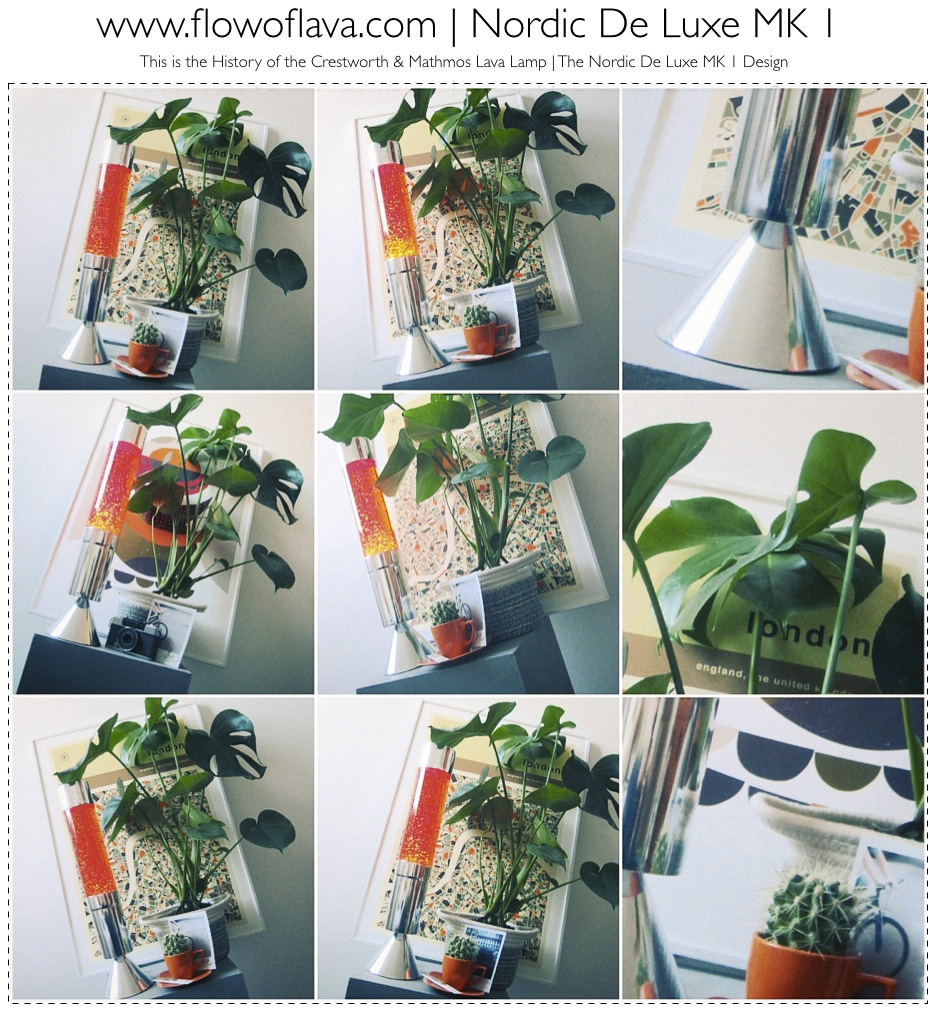
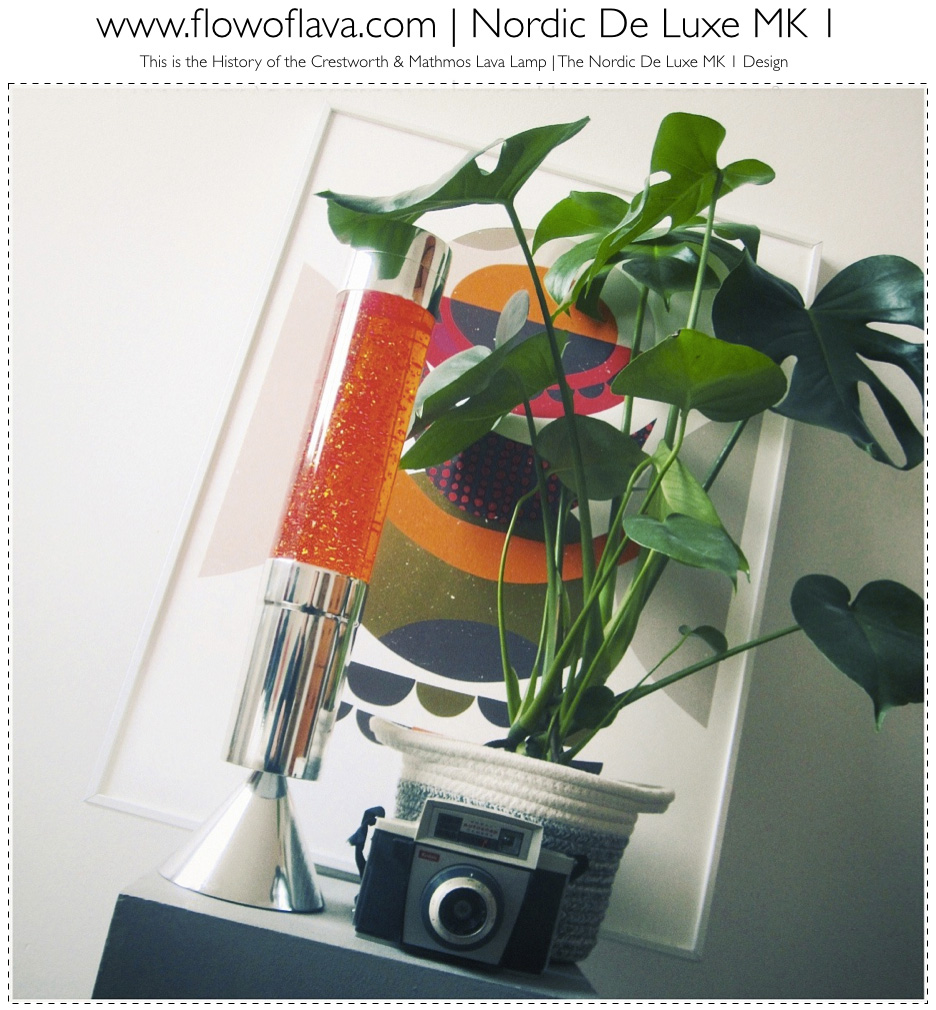
![]()
The Crestworth Icons | Astro Nordic MK 1 Design The images below show the Astro Nordic design that was designed by Crestworth and offered with Lava and glitter. The Nordic design features a beautiful cone base, where the whole lamp is elevated on the cone base which creates a stunning look and feel. These lamps were sold in copper and silver finishes. |
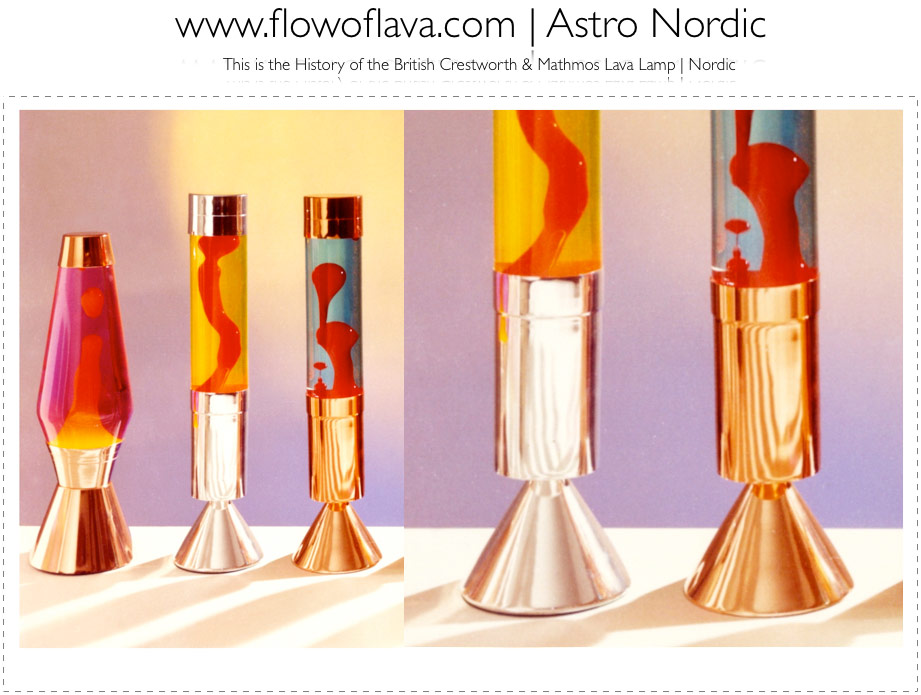
![]()
www.flowoflava.com | Astro Princess Elevated Table Top Design ... The early Crestworth "Astro" lamp range included a little known design known as "Princess" which features an elevated base design that is rarely seen and quite unusual. Featuring a construction similar to the vintage copper early Astro lamp, with a two-part base cone design that interlocks and sits on an elevated traditional scroll-base design. These lamps are rarely seen and very rare. The images below are the kind courtesy of Dermot Shanahan. |
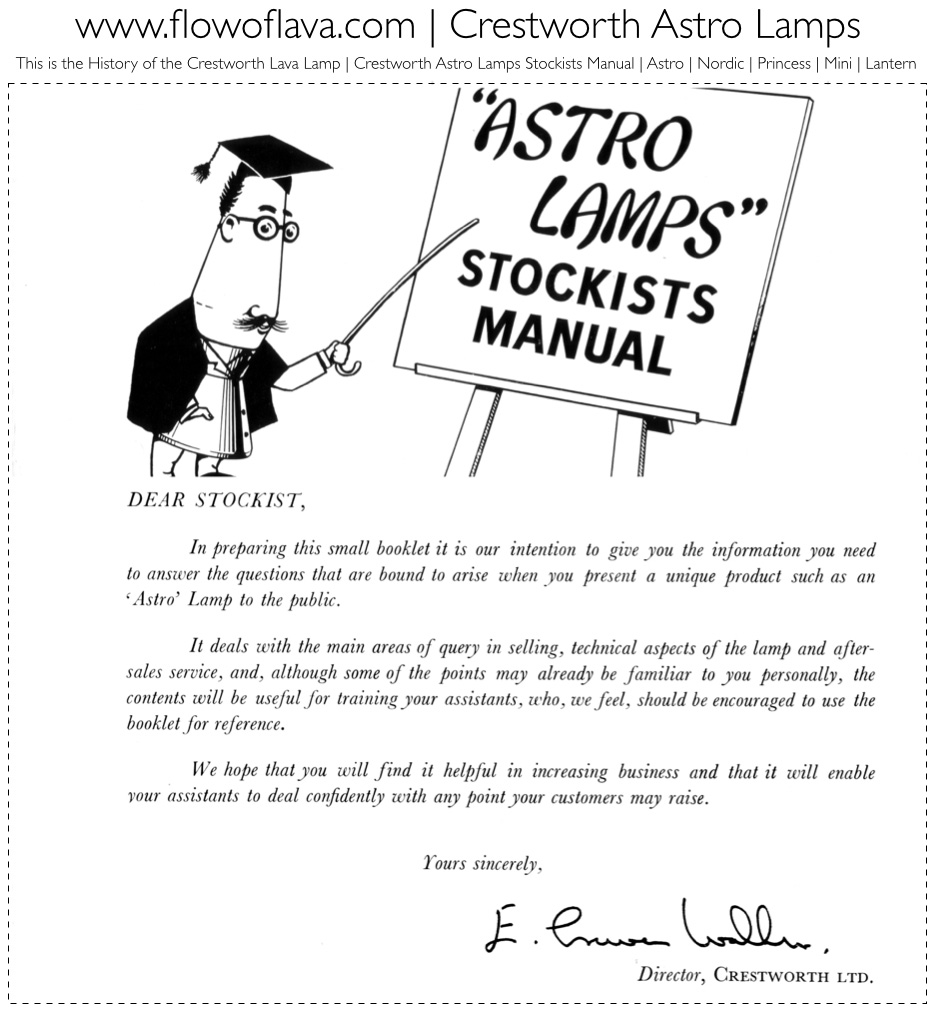
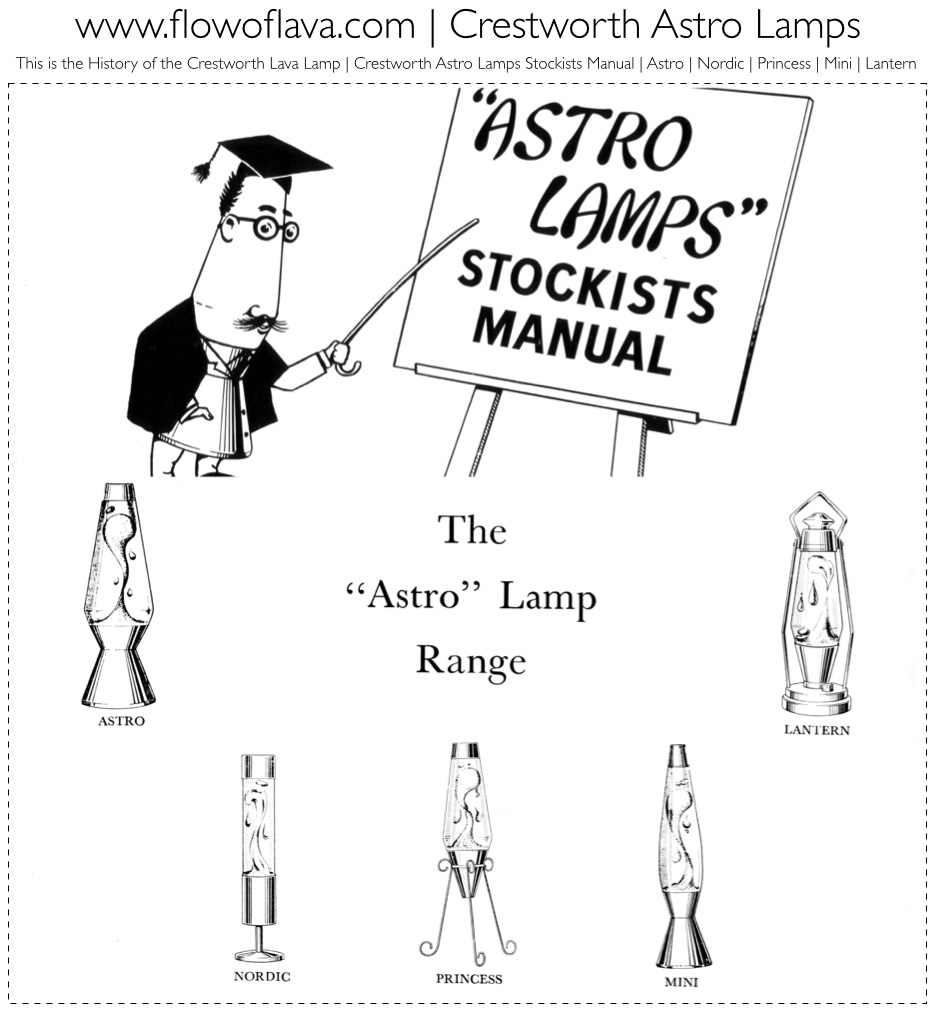
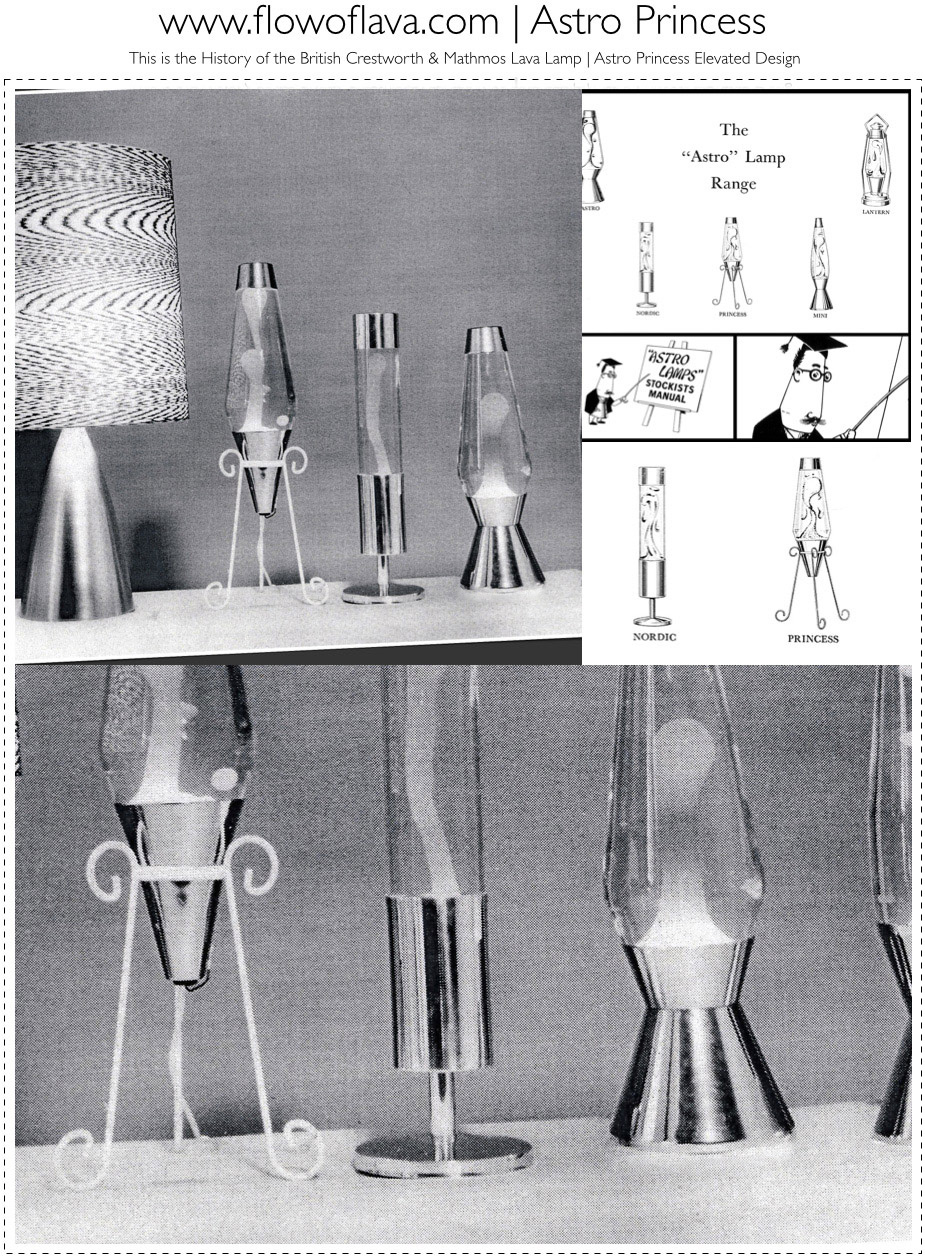
![]()
The Crestworth Icons | The Floor-Standing Designs | Princess Rocket | As seen in Mathmos 46 Vintage Exhibition Designed to create a statement, Princess (as known by the collecting community) Rocket is the largest vintage Crestworth lamp, which is a showcase to the magic of the Astro liquids. Featuring a cylindrical container housed on a tripod styled base, this lamp makes a statement unlike no other and is a beautiful piece of vintage design. Princess is one of the most elusive Crestworth lamps and a stunning mysterious piece of Crestworth’s history. These lamps were extensively used a tradeshows and were designed for public spaces. |

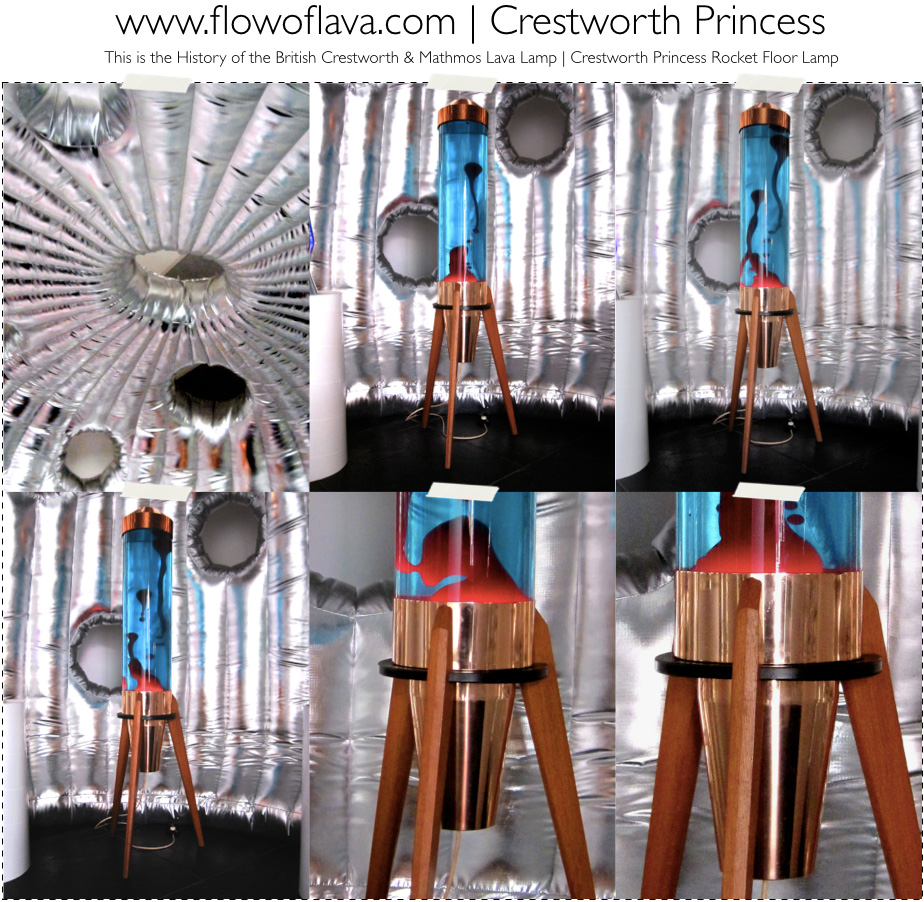
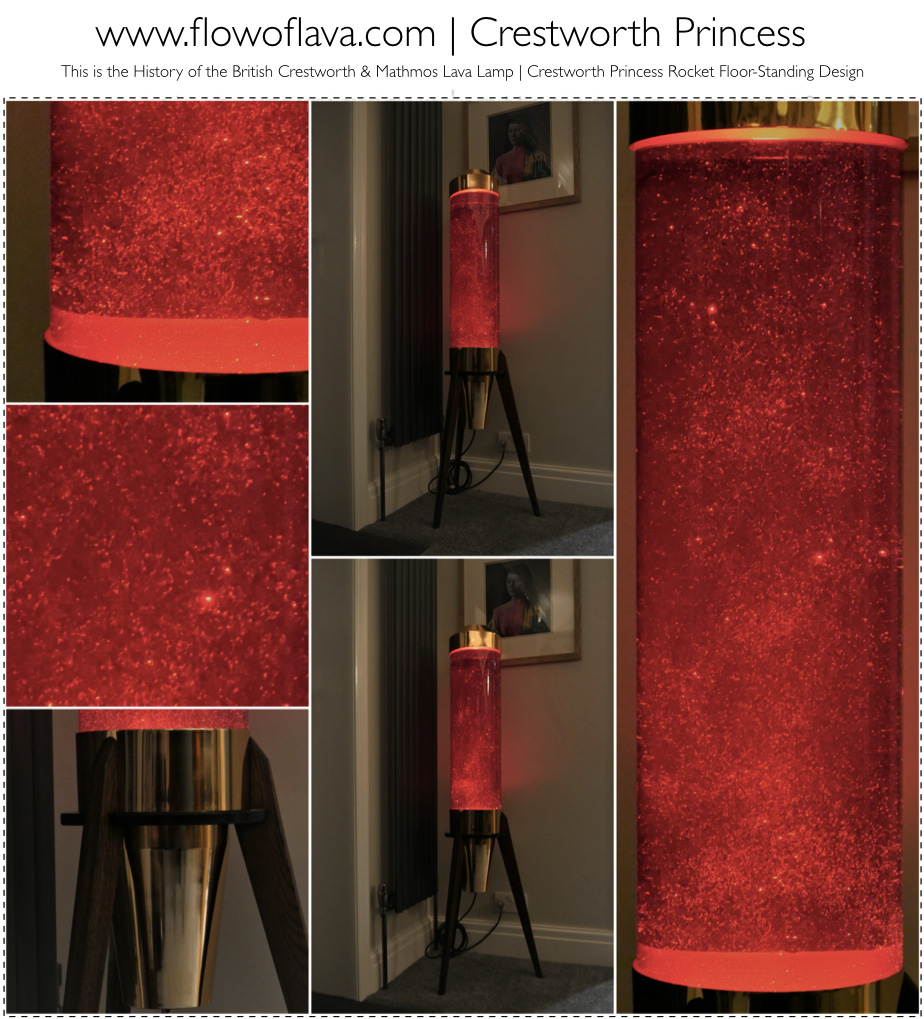
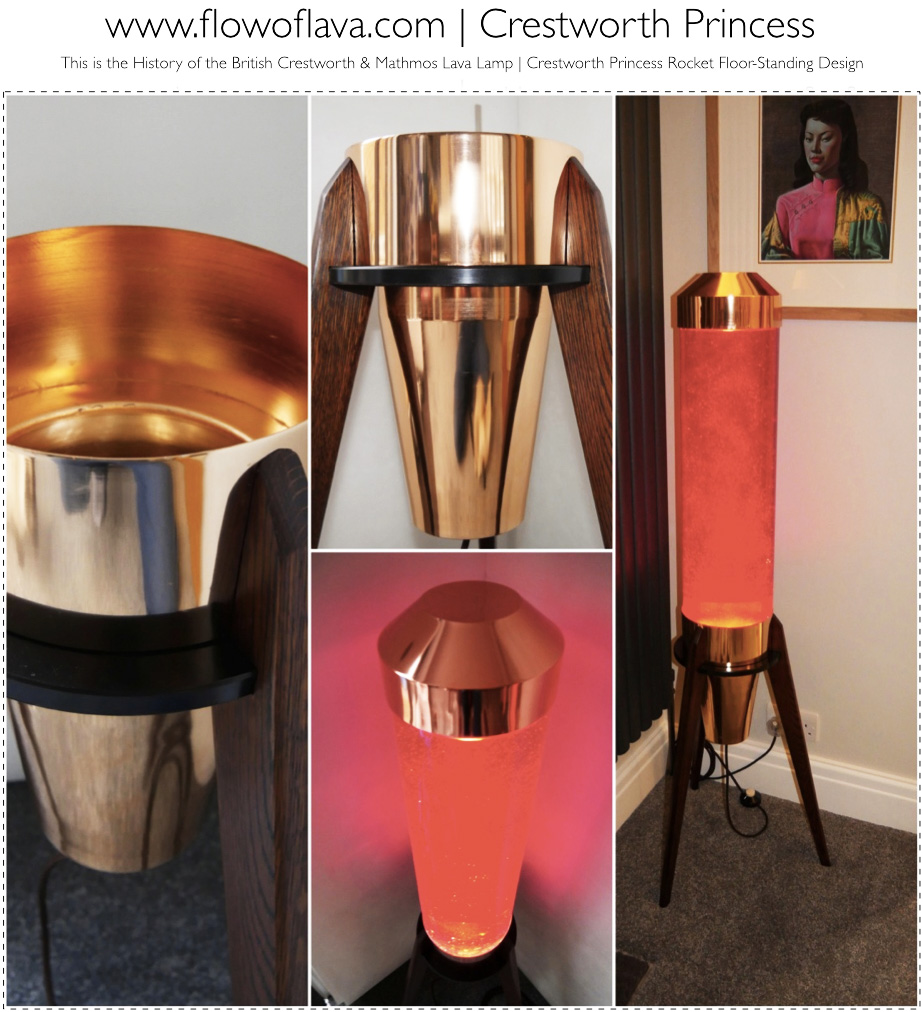
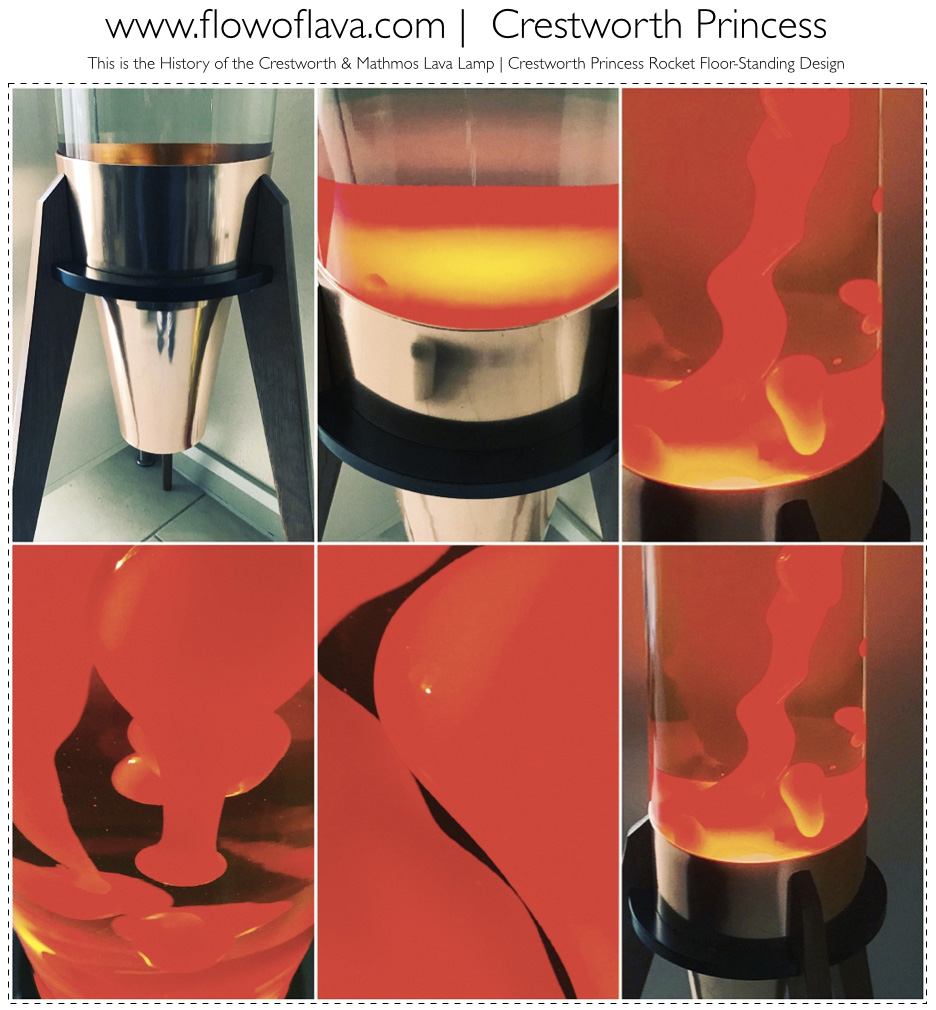
![]()
Below: The Cannon Timer - The Unique Non Electrical Crestworth Canon Timer. Crestworth produced a range of different non lava orientated products included: The Traction Lamp, The Cannon Timer and the Mistrolite. The Canon Timer features a tube that contains two liquids that which don't mix, it is used to act as a reminder and as the liquids exchange locations they represent time passing. This product is a very beautiful and very fragile. The Cannon Timer features movable wheels and the body of the product moves up and down. The bands also move so one can select a time frame to time. This model has only been seen with the clear/red colour combination. It is unknown the various colour combinations that this product featured. |
![]()
With its elegant Gold Plated finish, here is the ideal ornamental telephone timer (or luxury egg timer) with a difference, its fascinating rising coloured oil action is just the thing for those who prefer an intriguing "gentle reminder" to tire-some split-second accuracy). The Cannon Timer is a very elegant yet fragile piece, the model above is original and very elegant. It is a non electrical item from Crestworth and probably the only non-electrical item in the entire Crestworth product lineup. |
![]()
Crestworth on TV & Appearances | The Prisoner & Doctor Who. Early Crestworth Astros can be seen in the Cult 60s British TV series, The Prisoner. Please see below for screen shots from episodes 1-17. Early Crestworth Astros have shallower caps, thus when the fluid hasn't expanded when the lamp is a cold state, it shows the level of fluid. This was later changed with wider neck bottles and a much deeper cap. |
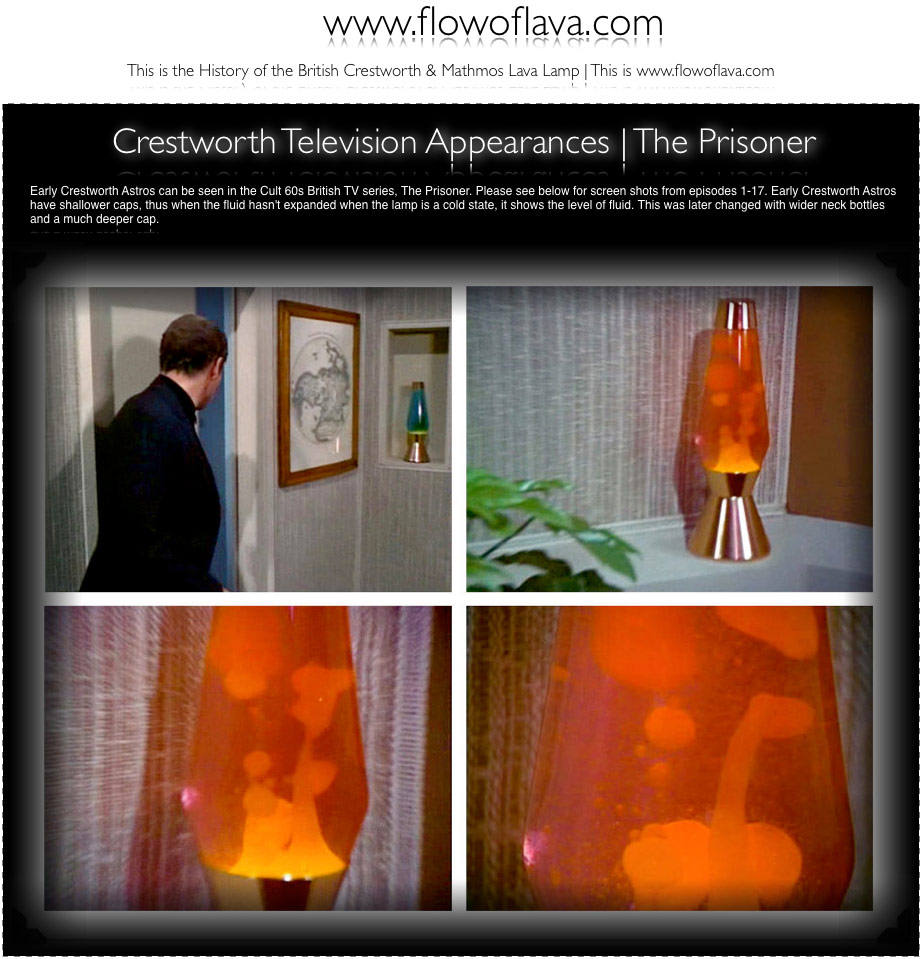
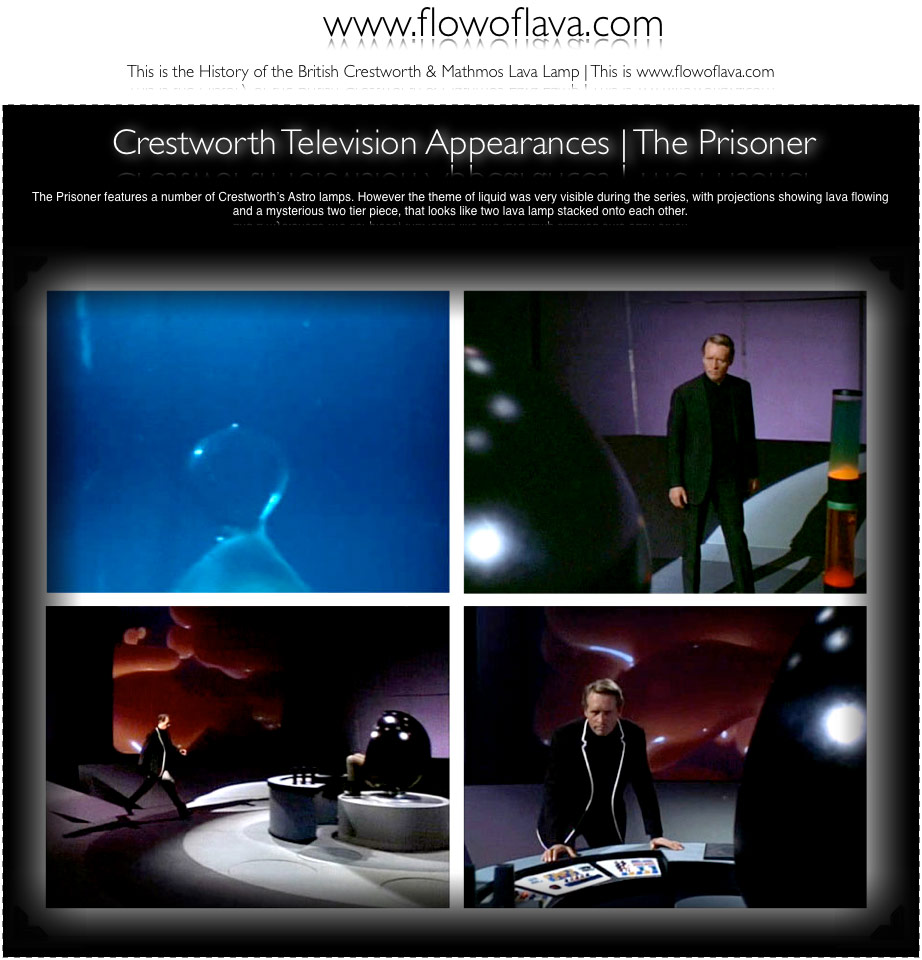
![]()
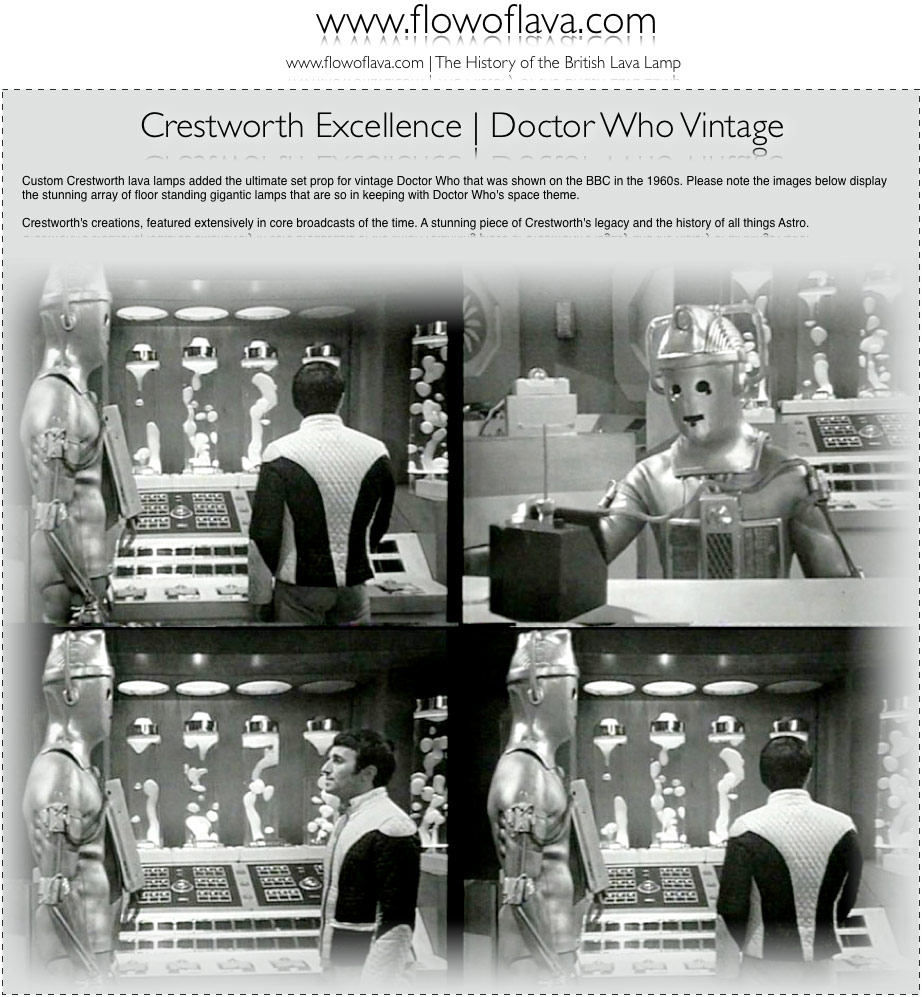
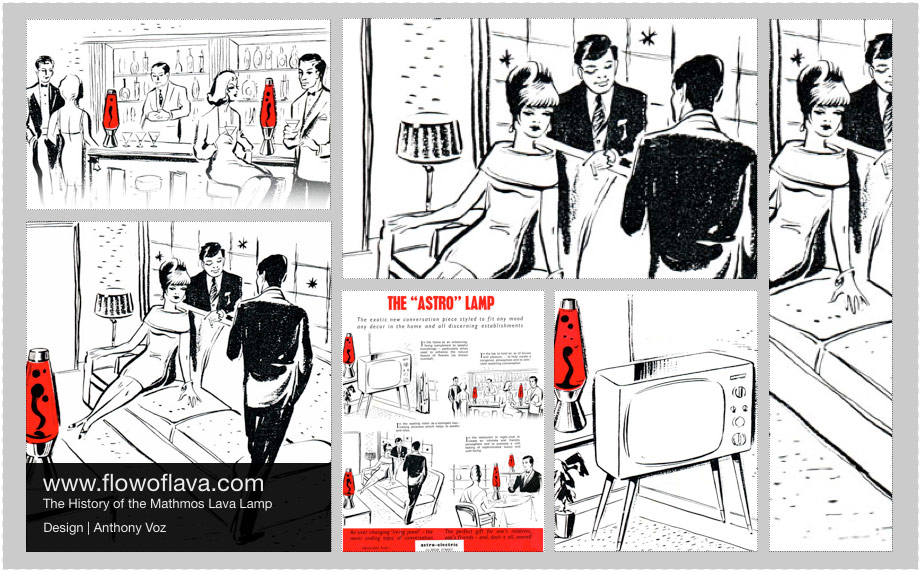
![]()
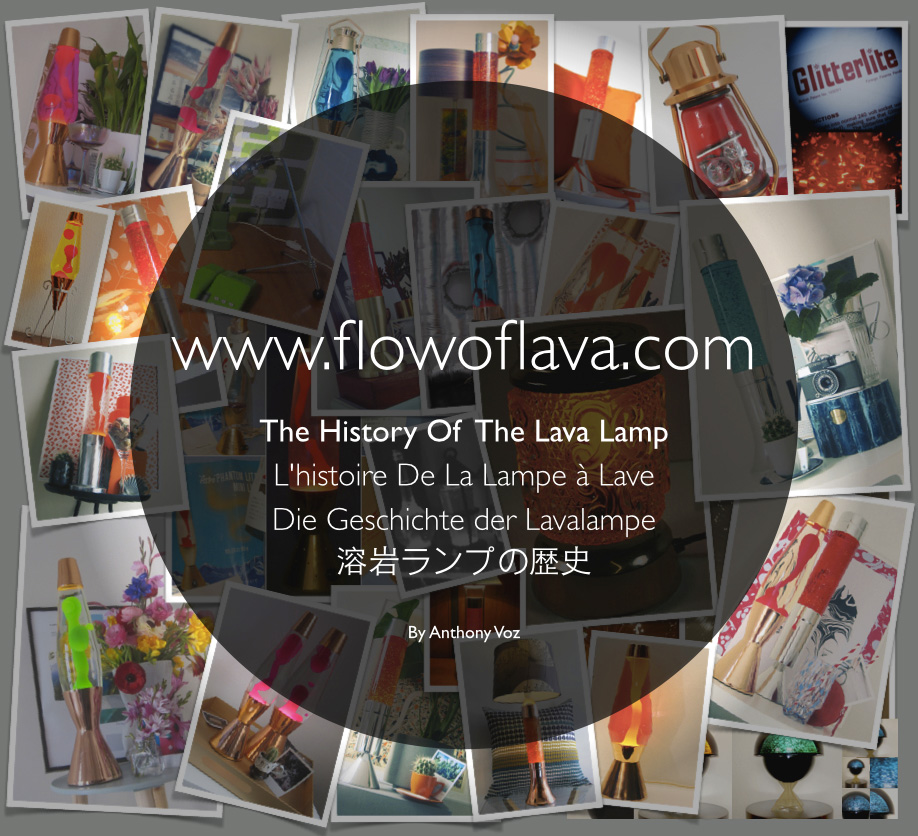
![]()
You are browsing www.flowoflava.com, a site dedicated to the history, heritage and nostalgia of the Original Mathmos Astro Lava Lamp. Created by Anthony Voz. Thank you for visiting www.lightoflava.com | www.flowoflava.com
